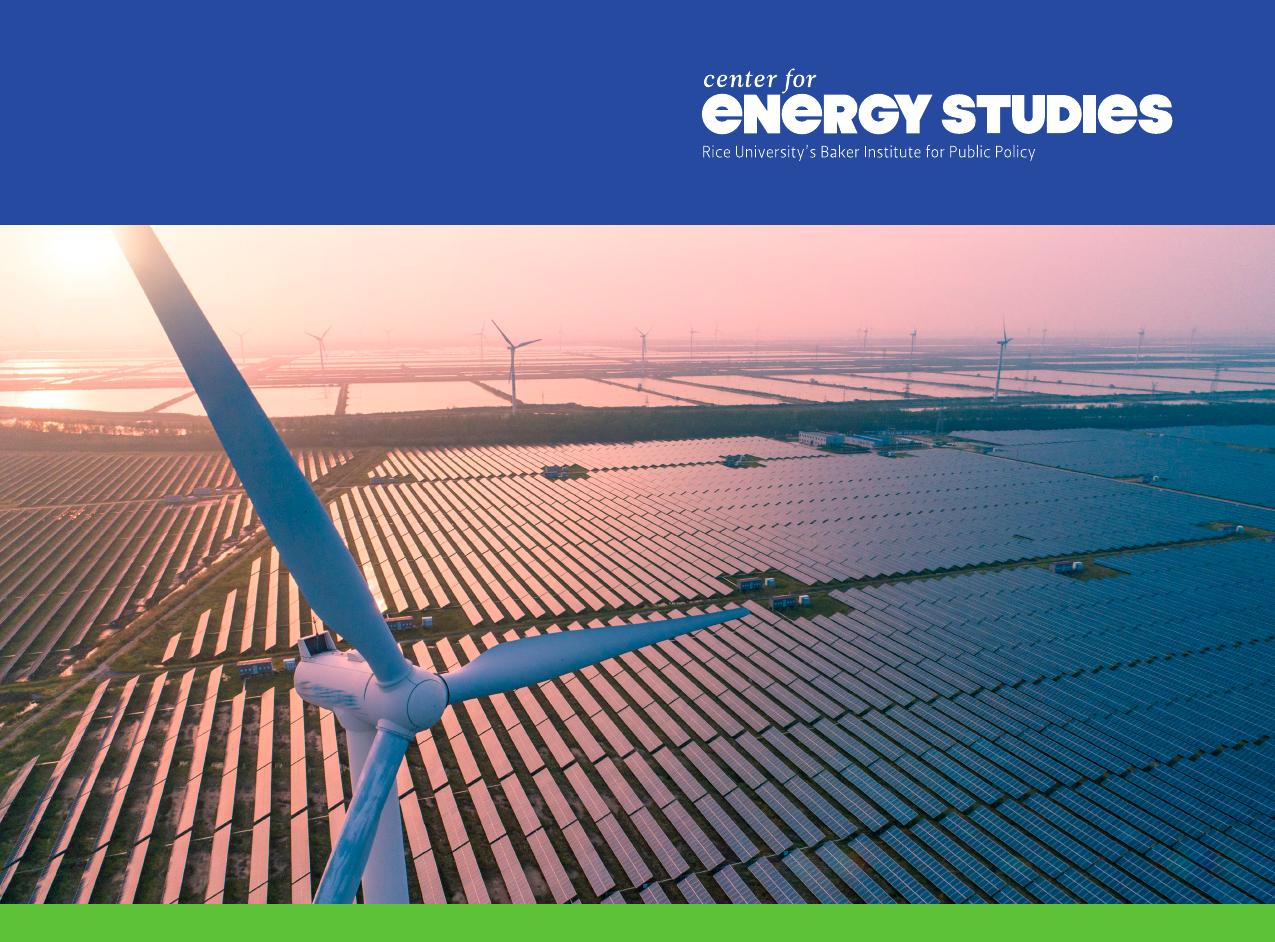PAVINGTHEROADFORCOMPETITIVEGREENHYDROGENHUBS:DOESCHILEHAVEACHANCE?BenignaCortésLeissNonresidentFellowinLatinAmericanEnergy,CenterforEnergyStudiesLindleyMaxwell,Ph.D.InvestigadorPrincipaldeEnergía,CentroCientíficoTecnológicoRegióndeAntofagastaCICITEMTilsaOréMónago,Ph.D.FellowinEnergyandMarketDesign,CenterforEnergyStudiesMay2023©2023byRiceUniversity’sBakerInstituteforPublicPolicyThismaterialmaybequotedorreproducedwithoutpriorpermission,providedappropriatecreditisgiventotheauthorandRiceUniversity’sBakerInstituteforPublicPolicy.Whereverfeasible,papersarereviewedbyoutsideexpertsbeforetheyarereleased.However,theresearchandviewsexpressedinthispaperarethoseoftheindividualresearcher(s)anddonotnecessarilyrepresenttheviewsoftheBakerInstitute.BenignaCortésLeissLindleyMaxwell,Ph.D.TilsaOréMónago,Ph.D.“PavingtheRoadforCompetitiveGreenHydrogenHubs:DoesChileHaveaChance?”https://doi.org/10.25613/42F2-EW17PavingtheRoadforCompetitiveGreenHydrogenHubs:DoesChileHaveaChance?3ExecutiveSummaryChile’seconomydecarbonizationprocessisunderway.Thecountryhasnohydrocarbonreservesandhaslimitedhydroresources.Ithashistoricallyreliedonimportedoil,naturalgas,andcoaltomeetitsenergyneeds.However,itsAtacamaDeserthasthebestsolarradiationintheworldwhiletheextremesouthhasthestrongestwindonshore.Asaresult,Chilealreadygeneratesmorethan20%ofitselectricityusingsolarandwindpower.Inthiscontextpursuingtheproductionofgreenhydrogenusingrenewableelectricityresourceshasbeenembracedbythegovernmentandin2020issued“TheNationalGreenHydrogenStrategyofChile”whichhasbothamedium-andalong-termvision.Thisstrategyreliesontheabundanceofrenewableresourcesandampleprivatesectorparticipation:Concentratedsolarpower,solarphotovoltaic,on-shorewindandrun-of-river,mayallowChiletoproducethecheapestgreenhydrogenontheplanetoncethetechnology,infrastructureandregulatorychallengesaretakencareof—includingfinancingandacceptancebythecommunityatlarge.Thetechnologyiscurrentlybeingtestedwithmultiplepilotprojectswithpublicandprivatefundingtoprovideincentivesfortheproduction,delivery,anduseofgreenhydrogen.Theyareexpectedtobefullytestedby2025forlocalconsumption,withthefirstphaseproviding:•Greenhydrogentoreplacethegrayhydrogen—fromhydrocarbonprocessesthatemitCO2—currentlyusedbyrefineriesandthechemical,cement,andsteelindustries.•Derivativesofgreenhydrogensuchasmethanoltoreplacedieselinheavy-dutytransportationinminingactivities,andinlong-distancetransportationviabuses,trains,andheavy-dutytrucks.•Greenammoniatoproduceexplosivesandfertilizers.Alargepartofthechallengeinscalinguptheproductionofthisnewfuelforthelocalandinternationalmarketisthedevelopmentofaregulatoryframeworkthatprovidescertaintyandtransparencyforitswholevaluechain.Greenhydrogenproduction,storage,transportationanddistribution,andendusersneedreliablerulesfortheinvestors,operators,consumers,andcommunitiessurroundingthesefacilities.Toincentivizereducingemissionsandlocaldemandofrenewablesincludinggreenhydrogen,Chilealreadyhasacarbontaxof$5.00/tonofcarbondioxidewhichthegovernmentisplanningtoincreaseto$35.00/tonofcarbonemissions.Anewlawonenergyefficiency(Law21.305)hasnowdefined“greenhydrogen”asafuel,ratherthanthepreviousdefinition—“adangerousextremelyflammableelement”—thatwasusedwhengreenhydrogenwasregulatedbytheHealthMinistry.Inaddition,Law21.505,approvedNovember2022,includedhydrogenstoragetobeusedasabackupfortheelectricsystem,tomanagetheintermittencyofrenewablepowergeneration.Asaresult,theMinistryofEnergyistheentityresponsibleforthisnewfuelanditsstrategyimplementation.PavingtheRoadforCompetitiveGreenHydrogenHubs:DoesChileHaveaChance?4Ithasdesignedacalendarwiththreephaseswiththepurposetoadaptexistingregulationsanddesignnewonestofacilitatethedevelopmentofthisnewenergyvector:FirstPhase2020-2023toelaboratetherulestomakegreenhydrogen,itsspecificationsanddelivery.SecondPhase2024-2027topreparetherulesforhydrogentransportbypipelinenetworks,technicalandsafetyrequirementsincoordinationwiththeMinistriesofTransportationandMining.ThirdPhase2028forwardtoprepareregulationsforhandlinghydrogeninportfacilitiesinconjunctionwiththeMinistriesofTransportationandDefense.Onecriticalobjectiveistohaveanefficientandsimplifiedregulatoryframeworkwheretheoperatorscanbenefitfromsubmittingtheirprojectenvironmentalrequirementstooneagency;the“onewindowconcept,”throughwhichallrequiredpermitswouldbehandledwiththepertinentagenciesinanexpeditiousmanner.Financingisavailablefrommultilateralandinternationalorganizationsaswellasthegovernmentwhichhasprovidedgrantstoindustryparticipantswithpilotprojects.MemorandumsofUnderstanding(MOUs)fortechnical,financial,andcommercialsupporthavebeensignedwithinternationalagenciesandorganizationsaroundtheworld.AtthesametimeChilehasdevelopedthemechanismsforconsultationwithlocalcommunitiesabouttheimpactstheymayexperienceduetothelocationoftheseplantsandtheuseofrenewableenergysources.Chile’snorthernregionhasalreadydevelopedcompetitivesolargeneration,anddesalinizationplants,andhasavibrantminingsectorwiththenationalcoppercompanyCodelcoandmultipleprivateoperators.Thisenvironmentispromisingforthedevelopmentofagreenhydrogenecosystem.Ashighlightedinthisreportthisregionalreadyhasmultiplepilotprojectsinvariousphases.Hydrogenexportscouldstartwithammonia,forwhichshipsareavailable,andlaterincludeliquidgreenhydrogenoncetechnical,safety,andcostissuesareresolved.Giventheprogressithasmadeonincorporatingrenewablesintoitsenergymatrix,Chileisonthewaytomeetingitsclimategoals—buttheurgencytodevelopgreenhydrogentofurtherreducecarbonemissionsinminingoperations,heavy-dutyandlong-distancetransportation,andagriculture,remains.PavingtheRoadforCompetitiveGreenHydrogenHubs:DoesChileHaveaChance?5TableofContentsIntroduction....................................................................................................................................6WhyHydrogen?..............................................................................................................................7EnvironmentalGoals:MitigatingClimateChange?.........................................................7HydrogenProductionandDemand..................................................................................10WhyChile?......................................................................................................................................17ComparativeAdvantagesofChileforHydrogenProduction...................................22OpportunitiesforChile’sHydrogenProduction...........................................................24AntofagastaasaHydrogenHub..............................................................................................32RegulatoryFramework..............................................................................................................33PotentialChallengestoHydrogenMarketsDevelopmentinChile.............................38DevelopingandScalingtheTechnologyandConsumerBaseforHydrogenUse...........................................................................................................................38RegulatoryChallenges...........................................................................................................38CommunityEngagementChallenges...............................................................................42ConcludingRemarks..................................................................................................................44References......................................................................................................................................46Appendix........................................................................................................................................56PavingtheRoadforCompetitiveGreenHydrogenHubs:DoesChileHaveaChance?6IntroductionAspartofglobaleffortstoachievenet-zeroemissions1by2050(IEA2021a),greenhydrogenhasemergedinrecentyearsasapromisingfuel.Greenhydrogen—hydrogengeneratedbyelectrolysisfromwaterpoweredbyrenewablesourcesratherthanprocessesusingfossilfuelenergysources—hasthepotentialtodisruptfossilfuelenergymarketsandreduceemissionsinmanysectors:Greenhydrogencanaddresshard-to-decarbonizesectorsinwhichelectrificationisnotaneconomicoption.In2020,agricultureandenergy(includingtransportation,industrial,andelectricityuse)togetheraccountedforover90%oftheworld’sgreenhousegasemissions(agriculture’ssharewas18.9%andenergy’s73.2%).2SouthAmericaaccountsforjust2.9%ofglobalcarbonemissions,3butwiththecleanestenergymatrix4ofanyregionworldwide(Elizondo-Azuelaetal.2017)andawealthofrenewableenergyresources,particularlyinChile,thisregionhasthepotentialtobecomealeaderinthegreenhydrogeneconomy.Indeed,ChilewasthefirstcountryinLatinAmericatopublishitsNationalGreenHydrogenStrategy.Ithasalreadyinitiatedseveralgreenhydrogenpilotprojects,capitalizingonthesuninnorthernChileandthewindresourcesinthesouth,whicharesomeofthecheapestandmostabundantintheworld.Itscomparativeadvantageextendsalsotoexistinginfrastructure—includingports,roadsandrailroads—plusminingoperationsthatcouldprovideanewsourceofdemandforhydrogen,particularlyintheAntofagastaRegion.Greenhydrogenisemergingasanenergyoptiontobeincludedinthecountryenergymatrix.Thepotentialdemand,nationallyandinternationallyforthisnewfuelisconsideredinthisreport.Large-scaleconsumersofgreenhydrogenincludeindustrieswherehydrogenisalreadyused,suchasammoniaproduction,aswellasminingandheavytransportationwherehydrogenderivativescouldreplaceexistingfuelsourcesandwherebatteriesmaynotbeaneconomicoption.Inthisreport,wediscusstheopportunitiesandchallengesinvolveddevelopingahydrogenindustryinChile,withparticularfocusonhydrogenprojectsusingsolarphotovoltaicpower.AgreatopportunitytohighlightinChileisthenationalcommitmentandgovernmentsupporttodevelopthishydrogenindustry,aswellasthefavorableglobalconditionswithincreasedfundingavailabletodevelopcleanhydrogenprojectsaswellasthedemandthatcouldpotentiallybesatisfiedbygreenhydrogenfromChile.Somechallengesidentifiedanddiscussedinthisreportare:•Technicalchallengesassociatedwithexistingandevolvingdifferenthydrogenelectrolyzertechnologiestobeadopted.•Economicandsocialcomplexitiesincludeprojectfinancingopportunities,supportivegovernmentpoliciesandarobustregulatoryframework,developingacompetitivemarket,andmaximizingcommunitybenefits.•Securingaccesstoeconomicalandsustainablerenewableenergysourcesinthemediumtolongterm.PavingtheRoadforCompetitiveGreenHydrogenHubs:DoesChileHaveaChance?7•Developingand/orupgradingtheinfrastructurerequiredforlocalandinternationaltransportandstorageofhydrogen.•Developingtheuseofhydrogenderivativesasafuel,andthecorrespondinglocalandinternationalinfrastructuretomeetdemand.Thefirstsectionofthisreportreviewstheimportanceofhydrogenasanalternativetofaceclimatechallengesandtheeconomy'sdecarbonization.Italsodiscussesconceptsoftheproductionanddemandofhydrogen,reviewsthesupplychainandtechnicalchallengesassociatedwithelectrolyzers.ThesecondsectionpresentsChile'scomparativeadvantagestoleadthegreenhydrogenmarketdevelopment,anditdiscussesthecurrentopportunitiesfordoingso.ThenextsectiondiscussestheadvantagesofAntofagastaasaHydrogenhub,andtheChileanregulatoryframeworkisbrieflypresentedinthefollowingsection.Wediscussthepotentialchallengestomarketdevelopmentinthefifthsection,andconcludingremarksarepresentedinthelastsection.WhyHydrogen?EnvironmentalGoals:MitigatingClimateChange?Overthepastfewdecades,climatechangehasemergedasaninternationaltopicofconcern,debate,andpolicyintervention.In2000,theUnitedNationsnamedclimatechangeasitsseventhMillenniumDevelopmentGoalandin2015asoneofits10SustainableDevelopmentGoals.InDecember2015theParisAgreement,alegallybindinginternationaltreatytoreduceemissions,settheambitioustargetoflimitingglobaltemperatureriseto1.5°Cor,atmost,2°C.5Currently194parties(193countriesandtheEuropeanUnion)havejoinedtheParisAgreement.Aspartoftheagreement,developedcountriesagreedtojointlyinvestUS$100millionperyearinclimatefinanceinitiativessuchastheU.N.’sGreenClimateFundby2020,andtocontinuethislevelofannualspendingthrough2025.Spurredbywidespreadpoliticalsupportandinvestment,solarandwindpowergenerationhaveexpandedsignificantly—particularlysince2010,whenaccesstofunding,policyincentives,andtechnologicaladvancesbegantomakethesetechnologieseconomicallycompetitivewithfossilfuels.In2021,arecord295gigawatts(GW)ofnewrenewablepowercapacitycameonline,drivenpartlybysupportivepoliciesinChina,theEuropeanUnion,andLatinAmerica(IEA2022d).6Thustheworldwideaverage,by2021,oftheelectricitygeneratedfromwindandsolarpowerwasabove10%;butSouthAmericancountrieslikeUruguay,ChileandBrazilarealreadyabovethoselevelswith35%,22%and14%respectively(seeFigures1and2).PavingtheRoadforCompetitiveGreenHydrogenHubs:DoesChileHaveaChance?8Figure1.TotalEnergySupplyCompositionbySourcebyCountry(2019)Source:EIAdatasetandOurWorldinDataBasedonBPStatisticalReviewofWorldEnergy2022andEmberYearlyElectricityData2023.54.4%42.3%11.0%14.0%27.2%2.7%29.4%0.0%5.0%6.7%32.2%21.4%12.0%3.6%13.1%39.7%33.2%47.6%36.1%40.2%39.2%80.0%43.6%38.1%0%10%20%30%40%50%60%70%80%90%100%ARGBOLBRACHL2020COLECUPERURYCoalNaturalgasNuclearHydroBiofuelsandwasteOilWind,solar,etc.PavingtheRoadforCompetitiveGreenHydrogenHubs:DoesChileHaveaChance?9Figure2.ElectricityGenerationCompositionbySource(2021)Source:EIAdatasetandOurWorldinDataBasedonBPStatisticalReviewofWorldEnergy2022andEmberYearlyElectricityData2023.Achievinghighlevelsofrenewableenergypenetrationontheelectricitygrid,however,hasbeenmademoredifficultbytheintermittencyofsolarandwindgeneration,whichreducesgridreliabilityandsecurityforelectricityusers.Inaddition,majorsectorsliketransport—especiallytrucksandotherheavy-dutyequipment—andindustryarehardtoelectrifyandsohaveremainedhighlyreliantonfossilfuels.Asthelightestelementonearth,hydrogenishighlyflammable,anditscombustiononlygenerateswatervapor.Duetoitsversatilepropertiesasanenergyvector,greenhydrogen—producedfromwaterinaprocessusingrenewablepower—hasemergedasapromisingoptiontoaddresstheabovechallenges:7•Itcanmitigatetheintermittencyofrenewableelectricitybystoringenergyforpowerplantstousewhensunandwindresourcesarenotavailable.•Itcanbeusedasafueltodecarbonizehard-to-abatesectorssuchasminingandheavy-dutytransportwhereusingbatteriesisnotaneconomicoptiontobackouthydrocarbonfuels,andindustriesthatrequirehigh-heatprocesseswhereelectrificationisneithereconomicallynortechnicallyviable.•Itcanalsohelptoreduceemissionsintheagriculturesectorifusedasaninputforammonia,akeyingredientinfertilizerthathastraditionallybeenproducedfrombrownandgrayhydrogen(whicharederivedfromfossilfuelsthatemitCO2).9%10%1%4%3%13%0.4%0.1%1%3%9%1%11%9%0.1%0.2%3%32%14%31%55%20%72%79%55%33%6%61%58%14%18%15%4%31%20%34%0%10%20%30%40%50%60%70%80%90%100%ARGBOLBRACHLCOLECUPERURYOtherrenewablesexcludingbioenergyBioenergySolarWindHydroNuclearOilGasCoalPavingtheRoadforCompetitiveGreenHydrogenHubs:DoesChileHaveaChance?10HydrogenProductionandDemandCurrentProductionandConsumption.Hydrogenhasbeenproducedandusedfordecades.Asof2020,globalhydrogenproductionandconsumptionamountedtoover90milliontons(Mt)annually.Themajority(96%)ofthishydrogenisproducedbysteam-reforminghydrocarbonslikemethane,lignite,andoils(IEA2021b).Theseprocessescangeneratelargequantitiesofhydrogenatcomparativelylowcostsbuthaveasubstantialcarbondioxide(CO2)footprint(about900milliontonsin2021)(ESMAP2020b;IEA2022b).Waterelectrolysis,usingelectricitytosplitwatermoleculesintohydrogenandoxygen,offersanalternativemethodtoproducehydrogen.Ifpoweredbyrenewableenergysourcessuchaswindorsolarenergy,thishydrogenisproducedwithzeroCO2emissionsandcanbeconsidered“green.”However,in2021lessthan0.04%ofpurehydrogenwasproducedusingwaterelectrolysisandrenewableenergy(IEA2022b;IRENA2020).Oneofthemostpromisingshort-termpotentialapplicationsofgreenhydrogenistoreplacethebrownandgrayhydrogen(producedfromhydrocarbons)alreadyusedbyindustriessuchasagricultureandpetroleum.Currentlyhydrogenisnotinternationallytradedlikeothercommodities.Indeed,64%ofthe90milliontonsofhydrogenproducedin2020wasproducedandconsumedon-site.Mosthydrogen(78%)isusedtomakeammoniaforchemicaloroilrefiningfeedstocks.Hydrogenisalsousedintheproductionofexplosivesandpetrochemicals(alsofromammoniaproduction),chemicalandsyntheticfuels,and,insmalleramounts,iron(asaninputfordirectreducediron,orDRI)andsteelproduction(IEA2021c;seehydrogenvaluechaininFigure3).HydrogeninSouthAmericaisprimarilyusedbyoilrefineries,theammonia-basedfertilizerindustry,andtoproducemethanol.BrazilandArgentinahadthelargestdemand(0.4milliontonseachby2019),followedbyChileandColombia(0.2milliontonseachby2019)(IEA,2021b).PavingtheRoadforCompetitiveGreenHydrogenHubs:DoesChileHaveaChance?11Figure3.SupplyChainofHydrogenNotes:()1)Brownandgrayhydrogenareextractedfromfossilfuelsviasteamreformingwithnotreatmentofthecarbonemissionsproduced.2)Bluehydrogenisextractedfromnaturalgasviasteammethanereformationandincludescaptureandstorageofcarbonemissions.3)Turquoisehydrogenisobtainedfromfossilfuelsbymethanepyrolysis,producingsolidcarbonandnoCO2emissions,withnoneedforcarboncaptureandstorage.4)Pinkandgreenhydrogenareextractedfromsplittingthewatermoleculethroughelectrolysisusing,respectively,nuclearandrenewableenergysources.()PEM=polymerelectrolytemembrane;AEM=anionexchangemembrane,andSOE=solidoxideelectrolyzer.Source:Diagramcreatedbytheauthors.Whilethefeasibilityofgreenhydrogendependsonavarietyoffactors,therearetwosignificantbarrierstoitslarge-scaleproduction:1)thecurrenthighcostofproducinggreenhydrogenrelativetocurrenthydrocarbon-basedtechnologyoptionsand2)thecostandcomplexityofhydrogenstorageandtransport,whichrequireseitherretrofittingexistingequipmentorbuildingnewinfrastructuretoaccommodatehydrogen’suniquecharacteristics.InputsupplyProductionStorageEnd-useFossilfuels(coal,naturalgas,oil)ElectricityRenewables:-Hydro-SolarPV-SolarCSP-Windpower-Biomass-RenewablenaturalgasWater(seawater,groundwater,treatedwater)GreenHydrogenElectrolysisSteamMethaneReforming,AutoThermalReformingorgasificationBrown/GrayHydrogenBlueHydrogen+CCUSOn-siteShortdistancetransportationviaroadandpipelinesLongdistancetransportation(inevaluation):-pipelines-shippingofliquifiedH2,orammoniaPowergenerationFeedstockindustryProcessheat:-Heat-intensivemanufacturing:steel,cementElectrolyzer(PEM,ALK,AEM,SOE)Electricity:NuclearPinkHydrogenElectrolysisProductionofderivatives:Methanol,Ammonia(usedforfertilizers/explosives),syntheticfuels(syngas).GascylindersUndergroundpipestoragesSaltcavernsLOHC-LiquidorganichydrogencarrierDistributionOilrefineriesMobility:-Masstransport:trains-Roadfreightandmarinetransport:trucks,ships-FuelcellvehiclesAgricultureMethanepyrolisis+solidcarbonTurquoiseHydrogenPavingtheRoadforCompetitiveGreenHydrogenHubs:DoesChileHaveaChance?12GreenHydrogenNeedsToBeEconomicallyCompetitivewithFossilFuels.Thiswouldrequirethecostofgreenhydrogen,whichcurrentlyfluctuatesbetweenUS$5andUS$9/kg(MacDowell2021),tobelowerthanUS$2/kg(equivalenttoUS$50/MWh)(seeTable4intheAppendix).8Costscanbereducedbyhavingaccesstolow-costrenewableenergyandbyimprovingtheefficiencyandaffordabilityofelectrolyzers.•Whensourcedfromsolarphotovoltaicenergy(PV)—currentlyoneofthelowest-costandmostreadilyscalablerenewableenergysources—electricityaccountsfor60%-70%ofthetotalcostofgreenhydrogenprojects(PatoniaandPoudineh2022a).9Thecostofelectricityingreenhydrogen-solarPVprojects,however,mayvarydependingonwhetheraprojectsourcesenergyfromadedicatedsolarpowerinstallationorcontractuallyfromthegridviaapowerpurchaseagreement(PPA).•Electrolyzers,ontheotherhand,accountforabout20%ofthetotalcostofhydrogenprojects(PatoniaandPoudineh2022a).Therearefourleadingelectrolyzertechnologies,eachwithdistinctadvantagesanddrawbacks:alkaline(AEL),polymerelectrolytemembrane(PEM),anionexchangemembrane(AEM),andsolidoxideelectrolyzers(SOE)(IRENA2020;PatoniaandPoudineh2022a).Thefirsttwoarealreadycommercialized,andthethirdisinamarkettestingstage,withpromisinginitialresults.Thefourth,SOE,isstillatanearlystageofdevelopment.Eachtypeofelectrolyzertechnologyhasdifferenttechnicalproperties(seeTable5intheAppendix)andentailsdistinctadvantagesanddisadvantagesintermsofmaterialsrequired,environmentalimpacts,andefficiency(seeTable6intheAppendix).Lowtemperatureelectrolyzers(PEM,AEMandAEL)havethemostpotentialforrapid,large-scaledeployment;fromtheseAEMandPEMarethebestelectrolyzersforminimizingsafetyissues(suchaswatercondensation),whileproducinghighpurityhydrogen:Bothproducehydrogenwithapuritygreaterthan99.99%(Santosetal.2021).PEMtechnologyhasbeenfoundtobethemostsuitableforintermittentrenewableenergysourcesbuttendstobemorecostlyduetotheuseofscarcecatalysts(platinumandiridium).10AEMuseslessexpensivecatalystssuchasnickelandisthusslightlycheaperthanPEMtechnology.Inadditiontoelectrolyzers,severalothersystemcomponentscontributetothecapitalexpendituresrequiredforgreenhydrogengeneration,whichshouldbeaccountedforbestefficiency.Theseinclude:1.rectifiersorpowertransformersthatallowconvertingalternatingtodirectcurrent;2.waterpurificationunitsthatarerequiredtoguaranteepurifiedfeedwaterwithlowconductivity(upto1microsiemenspercentimenterμS/cm)toavoidanydamagetotheelectrolyzers;3.coolingsystemsneededtodissipatetheheatgeneratedacrossthestagesofgreenhydrogenproductionmayaddtoelectricityusage—industrialcoolingmachinesand/orcost-effectivedrycoolersareoftenusedtolowerthetemperatureofproductgasesto10°C(nearambienttemperature);and4.compressors,requiredtoallowforoptimalstorageandtransportofhydrogenbycompressinghydrogentoafinalpressurethatvariesfrom80to900barsdependingPavingtheRoadforCompetitiveGreenHydrogenHubs:DoesChileHaveaChance?13ontheapplication—pipelineinjection,ammoniaproduction,etc.—(seeTable7intheAppendix)(Holstetal.,2021).TransportofHydrogenPresentsBothTechnicalandEconomicChallenges.Hydrogenisaveryflammableelement,anditiscolorlessandodorlesswhencombusted;itsflametendstobeinvisibleindaylight.Beingthelightestoftheelements,italsocanleakveryeasily.Inordertostoreandtransportit,hydrogenconditioning—changingitsphysicalconditionbutkeepingitschemicalproperties—isrequired:keepingitinagaseousstatethroughpressurization(loweringitspressure)andthenchangingittoaliquidstatevialiquefactionorcryo-compression(Clarkeetal.2022;SEA2023).AccordingtoSEA(2023),storinggaseoushydrogeninpressurizedtanks(between350and700bars)isthemostmaturetechnology.So,hydrogencanbetransportedbypipeline,truck,orship,invariousformsincludinggaseoushydrogen,liquidhydrogen,andasderivativessuchaspetrochemicals,ammonia,methanol,andalkalines/oleofins.Variouscompaniesandgovernmentsarepursuingavarietyoftransportationstrategies;forinstance,theworld’sfirstshipmentofliquidhydrogenfromAustraliatoJapantookplaceinMay2022.Alltypesofhydrogenanditsderivativesneedspecializedinfrastructuretoensuresafeandreliabledeliverytoendusers.Forexport,theportshandlingshippinganddeliverymusthavesuitabledepth,facilities,andsafetystandards.Buildingtheappropriatefacilitiesforconversionandreconversion,obtainingthecapitaltomakethesechanges,andgeneratingdemandforwhatwilllikelybeahigher-costproductmaynotmakeeconomicsense.Usinggreenammoniaforfertilizersandforexplosivesratherthanreconvertingittohydrogencan,however,reducesomeofthecostsassociatedwithimport.Formost,liquidammoniawilllikelyprovidethemosteffectivelong-distancegreenhydrogencarrierintheshortterm,becausetheinfrastructuretotransportammoniaalreadyexists(PatoniaandPoudineh2022b)andthereisanexistingfertilizermarketfortheammonia.HydrogenPotentialintheRegion.Accesstorenewableresourcesandbeingneartowherethereisproductdemandcanfacilitatethemarketdevelopmentofhydrogen.ThoughSouthAmerica’shydrogenmarketrepresentslessthan3%oftotaldemand(IEA2021b),itsabundanceofrenewableresourcesmakeitapromisingsitefordevelopinggreenhydrogen.Chile,inparticular,standsoutasthecountrywithhighestsolarandwindresourcesaroundtheworld(seeFigures4and5below),inthenorthernandsouthernregions,respectively.PavingtheRoadforCompetitiveGreenHydrogenHubs:DoesChileHaveaChance?14Figure4.PhotovoltaicPowerPotential(2021)Source:WorldBankGroup,“GlobalSolarAtlas:”https://www.worldbank.org/en/topic/energy/publication/solar-photovoltaic-power-potential-by-country.Figure5.MeanWindPowerDensityat100mAboveSurfaceLevel(2019)Source:TheWorldBankGroup,“GlobalWindAtlas.”Greenhydrogenprojectsandassociatedinnovationshavealreadyattractedinvestmentbygovernments(bothwithinSouthAmericaandelsewhere),multilateralorganizations,andsomeprivateinvestorsasameanstoreachdecarbonization,climateandenergysecuritygoals.AccordingtotheIEAasofOctober2022,1,201projectshavebeencommissionedworldwidesincetheyear2000toproducehydrogenandderivatives(ammoniaandmethanol)viaelectrolysis;65(5.4%)oftheseinSouthAmerica(seePavingtheRoadforCompetitiveGreenHydrogenHubs:DoesChileHaveaChance?15Figure6).Outofthesegreenhydrogenprojectsintheregion,43%areinChile(seeFigure7).Figure6.NumberofHydrogenProductionProjectsviaElectrolysisCommissionedSince2000to2030Note:Projectcountsincludeallrenewableenergysourcesineachhydrogenfacility,includingwindandhydropower,toproducehydrogen,ammonia,methanolandvariousproducts.Source:IEA,HydrogenProjectsDatabase,2022.82765581171114111181415132532325910310795110462515559112734108213020406080100120200020012003200420052006200720082009201020112012201320142015201620172018201920202021202220232024202520262027202820292030WorldSouthAmericaPavingtheRoadforCompetitiveGreenHydrogenHubs:DoesChileHaveaChance?16Figure7.ShareofGreenHydrogenProjectsbyCountryinSouthAmericaNote:Projectcountsincludeallrenewableenergysourcesineachhydrogenfacility,includingwindandhydropower,toproducehydrogen,ammonia,methanolandvariousproducts.Source:IEA,HydrogenProjectsDatabase,2022.ARG9%BRA19%CHL43%COL6%PER3%PRY15%URY5%Total:65projectsPavingtheRoadforCompetitiveGreenHydrogenHubs:DoesChileHaveaChance?17WhyChile?OneofthemostpromisingeconomiesinSouthAmerica,Chilewas,until2020,theonlyOECDmemberfromSouthAmerica.Moreeconomicallyadvancedthanitsneighbors,Chilealsofaceshigherenergyneedsandhigherpressuretodecarbonizeitseconomy,whichexplainsitsincreasingrenewablesourcesinitsenergymatrix(seeFigures8and9).UnlikeotherSouthAmericancountries,Chiledoesnothavefossilfuelreserves,soitmustimportoil,gas,andcoaltosatisfyitsdemand.Figure8.EmissionsofCO2andGDPpercapita(2021)Note:ThesizeofthebubblesindicatesthetotalannualCO2emissionsofthecountry.Source:OurWorldinDatabasedontheGlobalCarbonProject2022andtheWorldBankGroup.ARGBOLBRACHLCOLECUPERURYDEUUSA010203040506070809005101520GDPpercapita(currentUS$)ThousandsCO2emissionspercapita(TonnesofCO2,2021)PavingtheRoadforCompetitiveGreenHydrogenHubs:DoesChileHaveaChance?18Figure9.Shareofpercapitagreenhousegasemissionsbysector,2019Note:“Otherrenewables”includeswaste,geothermal,waveandtidal.Source:OurWorldinDatabasedonBPStatisticalReviewofWorldEnergy2022;Ember2023.WithAbundantRenewableEnergySources,ChileHasSignificantlyIncreasedItsParticipationintheEnergyMatrix.NorthernChilehasthehighestsolarradiationontheplanet:theAtacamaDeserthasanaverageannualdirectsolarradiationof2506kWh/m2,whichishigherthansolarradiationlevelsinSpain,AbuDhabiandtheU.S.(Moraga-Contrerasetal.2022).Thecountry’ssouthernregionhashighwindpotential,andunlikeotherregions,thereisnodifferenceinwindstrengthonlandandoffshore.Windturbines120metershighcanreachplantcapacityfactorsofover60%onland,equivalenttomuchmoreexpensiveoff-shoreturbinesinothercountries.Duetoitsabundantandhighqualitynon-conventionalrenewableresources,Chilehasbeenheavilyinvestingtoleverageitssolarandwindpower.Infact,itsrenewableenergypolicyhasalreadybeenprovedeffectivesincethecountryreacheditsgoalofhavingthesetwosourcesproviding20%ofitspowermatrixby2018,sevenyearsearlierthantheplanneddateof2025(BCNC2022).AsshowninFigure9,theroleofnon-conventionalrenewablesinthepowermixhasbeenexpandingsince2013,duetosignificantprivateinvestmentparticipationandpoliciesencouragingrenewableenergy.Overthepastsixyears,Chilehasincreaseditssolarandwindenergygenerationcapacityfive-fold.Ifexistingtrendscontinue,upto70%ofthePavingtheRoadforCompetitiveGreenHydrogenHubs:DoesChileHaveaChance?19country’selectricitycapacitymatrixwillbesourcedfromrenewableenergiesby2030(MinisteriodeEnergíadeChile,2020).TheCountryHasDevelopedaSuitableInvestmentClimateforRenewables.AccordingtotheWorldBankandESMAP’sRegulatoryIndicatorsforSustainableEnergy(RISE)score—aproxyforprogressintheinvestmentclimateforinvestmentinrenewables—by2021,Chile(withatotalscoreof87)outperformstheLatinAmericanandCaribbeanaverage(score61)andscoresevenabovetheOECDaverage(score86)(WorldBankGroup,2022).Withinthespecificrenewableenergypillar,Chileoutperformstoitsgroup’saveragesinmostofthefactorsoftherenewableenergy,suchascounterpartyrisk,networkconnectionanduse,attributesoffinancialandregulatoryincentives,incentivesandregulatorysupportforrenewableenergy,carbonpricingandmonitoring(seeFigure10).Figure10.RenewableEnergyPillar2021—RegulatoryIndicatorsforSustainableEnergy(RISE)ScoreSource:WorldBankGroup,RegulatoryIndicatorsforSustainableEnergy—RISE2022:https://rise.esmap.org/analytics.020406080100LegalframeworkforrenewableenergyPlanningforrenewableenergyexpansionIncentivesandregulatorysupportforrenewableenergyAttributesoffinancialandregulatoryincentivesNetworkconnectionanduseCounterpartyriskCarbonPricingandMonitoringChileOECDavgLACavgPavingtheRoadforCompetitiveGreenHydrogenHubs:DoesChileHaveaChance?20ChileLauncheditsNationalGreenHydrogenStrategyin2020.Inlinewithitsrenewableenergyexpansionandambition,ChilepublisheditsNationalGreenHydrogenStrategyinNovember2020(MinisteriodeEnergíadeChile2020).Itsetthegoalofbecomingagreenhydrogenproducerandexporterbyexpandingitselectrolysiscapacityto5GWby2025andthento25GWby2030—bywhichtimeChilewouldpotentiallybeproducingthecheapestgreenhydrogenintheworld,costinglessthanUS$1.50/kgofH2.Intheshort-termtheplanistomeetnationalhydrogendemand,whileinthelong-termtheobjectiveistoexporthydrogenanditsderivativeslongdistance—theglobaldemandislikelytobemanymagnitudesgreaterthanwhatcanbeusedinasmallmarketlikeChile.Accordingtoitsplan:•Pre-2025,prioritizedindustriesforhydrogendemandareoilrefineries,ammonia,mininghaultrucks,heavy-dutytransport,long-rangebuses,andblendinginnaturalgaspipelines(inproportionsofupto20%).•Post-2025,Chilealsoaimstodevelopapplicationsandusesofammoniaasshippingfuelandsynfuelsusageinaviation.Localdemandforhydrogenwouldcomeprimarilyfromlarge-scaleconsumerssuchasmining,steelmanufacturing,andcementcompanies;heavy-dutyandlong-distancetransportation;andammoniaforuseinfertilizersandexplosives.Chile’sNationalGreenHydrogenStrategy(MinisteriodeEnergíadeChile2020)helpedcreatearoadmaptodevelopthisindustry,layingoutasetofclearobjectivestoguidegreenhydrogenplanningandprojects.Guidedbythisframework,representativesinthepublicandprivatesectorarecurrentlyworkingandadvocatingtodevelopmoreconcreteandspecificpoliciesaroundtopicssuchascraftingclearregulatorysignalsanddevelopingavenuesforfinancialsupportsuchastaxincentivesunderan“actionplan.”Thisplanaddressesfourtypesofpolicy:•Policiestopromotedomesticandexportmarketsby1)makingavailablepublicfundingtosupportgreenhydrogenprojects,2)fosteringprivate-publicdiscussiontoimprovecarbonpriceandtaxpoliciesthatbettercapturethenegativeexternalitiesoffossilfuelssoastospurswitchingtohydrogenasafuel,and3)deployingagreenhydrogendiplomacytointernationallypositionChileasasourceofexportablecleanenergycarriers.•Policiesaboutstandards,safetyandpilotingtoprovideregulationstoreduceinvestors’uncertaintyandriskby1)developingaregulatoryframeworktoensuresafetystandardsthroughoutthehydrogenvaluechain,2)coordinatingaframeworktoeasepermitting/licensingandpilotinggreenhydrogenprojectsandderivatives,and3)reviewingtheregulationofnaturalgasanditsinfrastructuretopromotetheintroductionofhydrogenquotas.•Policiesforsocialandlocaldevelopmentaimingtoinvolvecommunitiesindecision-makingandachievetransversalsustainabledevelopmentby1)usingtransparentparticipatorymechanismsbetweencommunitiesandprojects,2)reducingmarketbarriersandexploringwaystoleveragehydrogenproductionPavingtheRoadforCompetitiveGreenHydrogenHubs:DoesChileHaveaChance?21intoisolatedelectricsystems,and3)assessingchallengesandopportunitiesofhydrogenrelatedtotheirlandandnaturalresourcesusage.•Policiestopromotecapacitybuildingandinnovationby1)identifyingneededcompetenciesandtechnicalskillsforthenewindustryinajointeffortbyindustryandacademia,2)buildinganR&Droadmaptodevelopfurthertechnologicalknowledgeandcapabilitiestoacceleratethegreenhydrogendeployment,and3)fosteringtheadoptionofgreenhydrogeninpubliccompanies.PilotProjectsinChile.ThoughsomeofChile’sspecifichydrogenpoliciesandincentivesarestillbeingdrafted,thecountryhasalreadyseenaboomingreenhydrogenpilotprojects.Theseprojects,whichareindifferentstagesofformation,spanavarietyofpotentialusesforhydrogen,includingfuelcellvehicles,blendingwithnaturalgas,anduseasaninputforammoniaproduction.Sofar,thepilotprojectsinthesouthofthecountryareshowingencouragingresults,andhavealreadyproducedsyntheticdiesel(e-dieselorcarbon-neutraldiesel)thatcanbeeasilyusedinexistingautomobiles,directlyreplacingtraditionalfuels(Hanley2022).Around39%ofthe28thegreenhydrogenprojectsinChileareexplicitlysolarphotovoltaic(PV)projects.Forthisreport,wefocusonlyonsolarPVprojects.Theseprojects,listedinTable1below,identifythemostpromisingapplicationsandstrategiesfordevelopingthegreenhydrogenindustryinChile,andmakethecountryanemergingincubatorforgreenhydrogeninnovation.Inthefuture,thesepilotprojectsmayhelpChilebecomenotonlyaproducerofgreenhydrogen,butalsoahub—andexporter—ofgreenhydrogentechnicalknowledgeandexpertise.Table1.CurrentlyAnnouncedGreenHydrogenProjectsintheAntofagasta/AtacamaRegionNameofProjectCompanyCapacityofElectrolyzerFinalUseStatusStartdateProjections()PlantaPilotoMovilCICITEM20kWFuelCellTestOperational2022tobedefinedAtacamaHydrogenHUBHumboldtHidrogenoVerde2.000MWAmmoniaPre-feasibility2027tobedefinedHydraMining3,Engie,HexagonPurus3MWCAEXFuelCellPre-feasibilityF2:2022F3:2023/2024F4:2025/2026AdelaidaAesAndes2.5MWH2FuelingStationFeasibility2024-HYEXEngie/Enaex26MWAmmoniaPre-feasibility2025F2:2030PavingtheRoadforCompetitiveGreenHydrogenHubs:DoesChileHaveaChance?22-FCAB3MWTrainFuelCellBuilding2024yes-GNA1.5MWTruckFuelCellPre-feasibility2025undefined-InvFarias14kWForkliftFeasibility2023yesAMERAirLiquideChile80MWMethanolFeasibility2025undefined-AESAndes-Ammonia-2025-Notes:()Fstandsforphase,i.e.,stageofprojectSource:CICITEM.ComparativeAdvantagesofChileforHydrogenProductionFourkeyfactorsmakeChileacompetitivelocationforagreenhydrogenindustry.PresenceofGloballyCompetitiveSolarResources.SolarradiationisabundantinChile’sAntofagastaregion,andinthatregiontheAtacamaDeserthasoneofthehighestlevelsofsolarradiationintheworld(ESMAP,2020a).Solarradiationintheregionhasloadfactorsof24%insingle-axismonofacialphotovoltaicpanels(andaround35%inthecaseofsingle-axistracking).11Also,thecountry’scentralregion,solarenergyisamorecompetitivesourceofelectricitygenerationthanfossilfuels.Itssolarpowercanbeprovidedatcheapcost.Gallardoetal.(2021)estimatethatinAntofagastathelevelizedcostofenergy(LCOE)fromanon-sitededicatedsolarPVfieldwasUS$21/MWhin2018butwoulddroptoUS$18/MWhby2025.12Likewise,theauthorsestimatedthattheLCOEforprojectswithpowerpurchaseagreementsPPAs(withconnectiontothegrid),whichwereapproximatelyUS$23/MWhin2018,woulddecreasetoUS$18/MWhby2025.Bywayofreference,theglobalweightedaverageLCOEforsolarPVisUS$48/MWhforsolarPVwithindividualprojects.13Overall,thecountrycouldsupportapproximately1,800GWofwind,solar,andhydroenergygeneration(MinisteriodeEnergíadeChile,2020).Hydrogencanbeusedintheelectricitysectortoprovidebackupforintermittentrenewables.AccessibleWaterResources.Chileisathincoastalcountrywithlargecoastline,whichmakesseawateraccessiblefortheelectrolysisprocess.Watermanagementinhydrogensystemsiscriticaltodevelopingasustainablehydrogenindustryandtominimizingtheindustry’scontributiontoregionalwaterstressandcompetition.PavingtheRoadforCompetitiveGreenHydrogenHubs:DoesChileHaveaChance?23Sincepurewaterisneededforelectrolysis,waterpurificationisrequiredwhenseawaterisused.Impurewater—waterwithhighconductivity,i.e.,withhighconcentrationofsalts—producescorrosionintheelectrodesdamagingtheelectrolyzer.14Waterpurificationsystemstypicallyaccountforjust1%-2%ofthetotalcostsoflarge-scaleelectrolysissystems(Holstet.al.,2021).Aslongasthewaterpurificationiseffective,electrolysissystemscanusemostwatersources,providingflexibilitytoselectasourcebasedonfactorssuchascost-effectivenessorsustainability.Thus,thecostofwatertreatmentcanvarywidely,asitdependsonthewatersource,thetransportdistanceandpossiblewastedisposal.Unliketapwater,15usingseawaterandwastewaterrequireadditionalpretreatmentprocesses—suchasupstreamdesalinationunits—whichaddcost.16Whileusefulinregionswithscantfreshwatersupplies,seawatermayalsoposeenvironmentalrisks(seeBox2).However,eventhemorecostlywatertreatmentprocessesarestillonlyasmallpartoftotalelectrolysiscosts.Thetotalcostof1m3ofdesalinatedwaterisUS$1.00,anddesalinatedwateramountstobetween1%-2%ofoperatingcostsforagreenhydrogenplant(IRENA2022b).Inregionswithlower-than-averageelectricitycosts—suchasnorthernChile—thecostofdesalinationcanbeevenless(IRENA2022b).Moreover,desalinationplantsarealreadyinplaceinAntofagastatosupplythewaterneedsofcommunitiesandminingoperationsintheregion.17NationalPolicyandGovernmentCommitmentToIncentivizeaHydrogenEconomy.TheChileangovernmentwasoneofthefirstgovernmentstopublishitsroadmapandnationalstrategyplanforhydrogenin2020.Furthermore,thecurrentgovernmentisconfirmingthiscommitmentandisimplementingthepoliciesneededtoincentivizethemarket.Someofthekeypoliciesinplaceare:•PublicfundingavailabilityforthedevelopmentofhydrogenprojectsthroughentitiessuchastheChileanProductionDevelopmentCorporation(CORFO).InDecember2021,CORFOawardedatotalofUS$50million,intheformofgrants,tosixrenewablehydrogenproductionprojects(IRA2022).InNovember2022,thegovernmentsignedtwoagreementswithmultilateralbanks,onewiththeWorldBankGroupforatotalofUS$350millionsandtheotherwithInterAmericanDevelopmentBank(US$400million)tofundgreenhydrogenprojects.18CORFOhasbeeninvitedtobepartofthenewHydrogenforDevelopmentPartnership(H4D)—aglobalinitiativeoftheWorldBankGroupannouncedduringCOP27—thataimstoboostthedeploymentoflow-carbonhydrogenindevelopingcountries.•Acarbonpricing(taxing)policyhasbeenimplementedsince2017.AlthoughthecarbontaxisnothighasinEuropeancountries--inChilethetaxhasbeenleviedatarateofUS$5/tonCO2—theexistenceofthecarbontaxsignalstothemarketthenationalobjectivetowardsdecarbonization.Inaddition,theinstitutionsinvolvedPavingtheRoadforCompetitiveGreenHydrogenHubs:DoesChileHaveaChance?24mayhavealreadysufficientexperienceandinformationtobetteroptimizethismechanism.RobustExistingInfrastructuralNetworks,includingpipelines,ports,androadslocatednearareaswithhighsolarpotential,whichcouldsupportthetransportandevenexportofgreenhydrogen.Currentpipelineinfrastructure—AtacamaandTaltalpipeline—primarilybuildtotransportgas,canberepurposedtotransportsyngasbyblendingnaturalgaswithhydrogen(upto20%)withminimalmodifications(IEA2022b).Newerinfrastructurecanbebuiltoncethemarketexpands.TheexistingpipelineisalsoconnectedtotheMejillonesseaport,openingthepossibilityofexportsinthefuture.TheMejillonesseaportisalsoconnectedtotherailroadnetworkandtothemainroadnetwork.OpportunitiesforChile’sHydrogenProductionTheglobalcrisisthatbeganwiththeCOVID-19pandemic,nowaffectedalsobytheRussian-Ukrainianwar,hasreinforcedthepushtospeeduptheenergytransition,toattainenergysecurityandreachclimategoals.Withthesignificantgrowthinglobalinterestondevelopinglow-carbonhydrogenmarkets,resourcestodevelopthetechnologyneededtoscaleuphydrogenproductionhavebecomemorewidelyavailable.Inlinewiththistrend,weidentifybelowseveralopportunitiesforChile.WiderCollaborationAcrossInstitutionsattheNationalandInternationalLevel.Recognizingboththeeconomicandenvironmentalpotentialsofgreenhydrogen,keyrepresentativesfromprivate,public,andacademicsectorshavestartedcollaborationswithnationalandinternationalgreenhydrogenassociations.TheChileanhydrogenassociation(H2Chile)wascreatedin2018toacceleratetheenergytransition,promotinghydrogenasanenergyvectoranditsuseinavarietyofapplicationsfromindustrial,commercial,residentialtotransport.Morethan60companiesfromtheenergysectorandrelatedmarketsparticipateinthisassociation,includingenergycompaniessuchasEngie,Enel,AirLiquide,EDFrenewables;engineeringservicecompaniessuchasABB,Siemensenergy,FinningCAT;miningcompaniessuchasAngloamerican,AntofagastaMinerals,andCodelco;andalsoshippingtransportcompaniessuchasGEN(grupodeempresasnavieras).19H2Chileisalsoastrategicallyofabroaderregionalcollaborationplatform:theHydrogenCongressforLatinAmericaandtheCaribbean(H2LAC).20H2LACwasfoundin2020bykeyinternationalpartnersincludeEuroClima+fromEuropeUnion,ECLAC,theDeutscheGesellschaftfürInternationaleZusammenarbeit(GIZ),andtheWorldBank.ParticipantsfromthepublicsectorincludetheministriesofenergyofChile,Colombia,Argentina,Uruguay,andBolivia,amongothers.Additionally,therearesectoralpublic-privateinitiativessuchastheCorporacionAltaLeythatemergedfromtheNationalMiningProgramofAltaLey—itcoordinatespublic,private,andacademiceffortstopromoteinnovation(R&D),productivityandcompetitivenesstowardsustainabledevelopmentintheminingindustry.Createdin2015byCORFOaspartofits“Strategicprogramofsmartspecialization”(ProgramaEstratégicodeEspecializaciónInteligentedeCORFO).CorporaciónAltaLeylauncheditstechnologicalPavingtheRoadforCompetitiveGreenHydrogenHubs:DoesChileHaveaChance?25roadmapfortheminingindustryin2019;itincludestheuseofgreenhydrogenintheindustry.TheAltaLeyorganizationalsohasalliedinstitutionsinPeru,BrazilandEcuador,andrecentlypublished,inconjunctionwithSAMMIinPeru,thefirstbinationalroadmapfortheimplementationofgreenhydrogenintheminingsectorinPeruandChile.21PrivateCompaniesinChileareAlsoWillingtoCommitandInvestinGreenHydrogen.AsofAugust2022,theChileanelectricgenerationindustryhadcommittedtoinvestingUS$23billioninrenewableenergyoverthefollowingfiveyears,15.5%—aroundUS$3.6billion—ofwhichwilldedicatedtogreenhydrogenprojects—44%isallocatedtosolarpowerand30%towind(MinisteriodeEnergíadeChile2022b).Figure11showstheshareofinvestmentcommitmentsbyproject.Figure11.Chile:InvestmentCommitmentinGreenHydrogenProjects,SharebyProject(2022)Source:MinistryofEnergyofChile.HaruOni1.86%Hyex1.28%FaroSur13.66%Plantae-fuelsCaboNegro27.31%PaunaGreenerFuture14.75%ProyectoAndes40.97%H2CSP+PVCerroDominador0.16%Total:USD3661millPavingtheRoadforCompetitiveGreenHydrogenHubs:DoesChileHaveaChance?26GreaterFinancingforHydrogenWorldwideCanBoostMarketDevelopmentandAccelerateHydrogenTechnology.Substantialinvestmentinhydrogencanacceleratethetechnologicaladvancesrequired;developingimprovedelectrolyzers,distributionandtransportationsystems.Therefore,itcanleadtofastermarketdevelopment,bydiversifyingandscalingupdemand.Eveniffinancingisnotavailabletoallprojects,theseinvestmentswillcertainlyhavespillovereffectsinfavoroftheglobalmarket,byimprovingtechnologyandreducingcosts.FinancingbyMultilateralOrganizations.MultilateralorganizationshavealsomadefundinginitiativesavailableforgreenhydrogenprojectsinLatinAmericaviaclimateandcleanenergyfunds.Severaloftheseinitiativesaredescribedbelow:•TheClimateInvestmentFund(CIF),comprisedoftheCleanTechnologyFundandtheStrategyClimateFund,isan$8billionmultilateralclimatefinancepartnershipthatchannelsprojectfinancingthroughtheWorldBankGroup,theInternationalFinanceCorporation,andfourdevelopmentbanks(Inter-AmericanDevelopmentBankIDB,AfricanDevelopmentBank,AsianDevelopmentBankandtheEuropeanDevelopmentBank).InLatinAmericatodate,CIFhas117approvedprojects—inBrazil,Colombia,Argentina,Peru,Ecuador,Paraguay,Bolivia,Mexicoamongothers—involving$1.3billioninfundingand$11.6billioninco-financing.Asignificantshare,60%,ofthosefundsisdirectedtoprojectsunderthescopeoftheCleanTechnologyFund,whichincludesgreenhydrogen.•InJuly2022,theIDBandGreenClimateFundannouncedtheco-creationoftheE-mobilityProgramforSustainableCitiesinLatinAmericaandtheCaribbean.Thisprogramwillprovide$450millioninconcessionalloansandgrantstonineLatinAmericancountriestodevelophydrogenprojectsrelatedtotransportation(IDB2022).Additionally,theIDBhasbeenworkingonsupportingpoliciestostrengthenadequateregulationsfornewtechnologies.Forexample,itapproveda$300millionpolicyloanforChile,tohelpthecountry’senergytransitionprocess,todevelopregulationanddevelopmentofgreenhydrogen(MadrigalMartinez2022).•HydrogenforDevelopmentPartnership(H4D)isaglobalinitiativeoftheWorldBankGroupannouncedduringCOP2722thataimstoboostthedeploymentoflow-carbonhydrogenindevelopingcountries.•ScalingClimateActionbyLoweringEmissions(SCALE),amulti-donorprogramcomprisedofstates,theprivatesector,andfoundationsthatissupportedbytheWorldBank,willpoolfundingforimpactfulprojectstoreducegreenhousegasemissions.Itsinitialfundingtargetis$1billionbytheendof2023,anditexpectstoincreasethisinvestmentto$5billioninthemedium-termPavingtheRoadforCompetitiveGreenHydrogenHubs:DoesChileHaveaChance?27PublicFinancing.ThelargestsovereigninvestorsinhydrogenareJapan,theEuropeanUnion,Germany,andtheUnitedStatesofAmerica.•Japan.Byearly2022,theJapanesegovernmenthadinvested$670milliontodevelopthehydrogenandfuelcellbusinessaspartofitsnationalstrategytobecometheworld’sfirsthydrogensociety(IRENA2022b).Fuelcelltechnologyisstillintheearlystagesofmarketdevelopment.•EuropeanUnion.TheEuropeanUnionhasallocated$4.56billioninannualfundingforhydrogenprojectsfortheperiod2021-2030.InNovember2021,theEUCommissionjoinedtheCleanHydrogenPartnership,apublic-privatecollaborationtosupportresearchandinnovationinhydrogentechnology,withaninitialinvestmentof$1billionforthe2021-2027periodandasubsequentinvestmentof$211millioninMay2022,aspartofitsREPowerEUPlan(IEA2022b).•Germany.Duringthe2022COP27meeting,GermanyannouncedthatitsKfWDevelopmentBankwouldinvest$572milliontospeedthedevelopmentofaglobalgreenhydrogeneconomyandfast-tracktheenergytransition,acontributionthattheyplantoincreaseto$2.5billionovertime(SteffenandBraun2022).•UnitedStates.TheU.S.hasalsocommitted$9.5billionoveraperiodoffiveyearsforthedevelopmentofcleanhydrogentechnology—thatincludesgreenhydrogentechnologyamongothers—andhydrogenhubdemonstrationprojectsthroughitsInfrastructureInvestmentandJobsAct.InitsHydrogenEarthShotprogram,theU.S.hasalsoseta“1-1-1goal”toreducethecostofcleanhydrogento$1per1kilogramin1decade(IRENA2022b).TheInflationReductionActcreatedadditionalsupportthroughataxcreditofupto$3/kgforproductionofqualifiedcleanhydrogen23(withlowestassociatedemissions)fora10-yearperiod.Althoughrulesandproceduresarestillbeingdefined,thesefundsmayindirectlyhelpothernationsbyloweringthecostofgreenandothercleanhydrogentechnologyandmakinginvestmentinhydrogenprojectsmoreappealingandbystimulatingdemandforcleanhydrogen.PrivateFinancing.Theprivatesectoroffersathirdsourceoffunding.Justrecently,theBezosEarthFund,theRockefellerFoundationandtheU.S.StateDepartmentannouncedtheEnergyTransitionAccelerator(ETA),whichcouldhelptocatalyzeprivatecapitalforcleanenergytransitioninemerginganddevelopingcountries.24GlobalInterestinScalingUptheElectrolyzerMarket.Anumberofcountrieshaveimplementedpoliciestoencourageelectrolyzermanufacturingthatshouldreducecostsasproductionscalesupandsubsidiescomeintoeffect.By2022,25countries(almostdoublethe2020count)andtheEuropeanUnionhadcreatednationalhydrogenstrategiesthatsettargetsforexpansionofelectrolysistechnologies(IEA2022b).TheEuropeanUnion,forexample,aimedtoinstallatleast6GWofelectrolysiscapacitybetween2020and2024,andexpandsuchelectrolysiscapacityto40GWbefore2030,accordingtoitsHydrogenStrategyin2020.Chileaimstoinstall5GWofelectrolyzercapacitybytheendof2025.PavingtheRoadforCompetitiveGreenHydrogenHubs:DoesChileHaveaChance?28Toachievethesegoals,theproductioncapacitiesforelectrolyzersmustbeexpandedsignificantly.Thesetargetswillrequireasignificantexpansionofglobalelectrolysiscapacity,whichin2021wasapproximately500MW(upfrom300MWregisteredin2020)(IEA2022a).Buteffortsarebeingmade.InMay2022,withaJointDeclarationsignedbetweentheEUCommissionand20electrolyzermanufacturers,theindustryagreedtoreachacombinedannualelectrolyzercapacityof17.5GWby2025andtokeepincreasingcapacityaccordingtothedemandby2030(EuropeanCommission2022).ExpectedCostReductionofElectrolyzers.Currentlyallexistingelectrolyzertypesaremoreexpensivethantraditional,carbon-intensivemethodsforproducinghydrogen.However,somefactorsindicatethatelectrolyzercostswilllikelydecreaseinthecomingyears:•IncentivesforImprovingElectrolyzers.IncentivepackagessuchastherecentlypassedUS’sInflationReductionActof2022(IRA)arelikelytohelplowerthecostsofelectrolyzers.TheIRAprovidesaUS$3/kgsubsidyforhydrogenproducedwithminimumCO2,andalsoearmarksfundingfordevelopingtechnologyandapplicationsforgreenhydrogen.TheIRAandotherpolicieswilllikelyincreasethedemandforelectrolyzers,potentiallycontributingtoeconomiesofscaleandmanufacturingefficienciesthatwillhelpreducetheirprice.•CompetitionandInnovation.Whilerisingdemandwilllikelyencouragemanufacturerstocompeteandreducecosts,ongoinginnovations(Figures12and13)—asevidencedbyagrowingnumberofelectrolyzerpatents—mayalsohelpimproveefficiencyandreducematerialscosts.CompaniesincludingSiemensEnergy,PlugPower,Toshiba,AirLiquide,McPhyEnergy,ITMPower,Idroenergy,andNextHydrogenaredevelopingorimprovinguponelectrolyzertechnologies(Deza2022).Infact,twoEuropeanmanufacturershavealreadyannouncedthatconsiderablecostreductionsareanticipatedby2025.2529PavingtheRoadforCompetitiveGreenHydrogenHubs:DoesChileHaveaChance?Figure12.EvolutionofPatentsandCostofSolarPVEnergy(2002-2019)Sources:EPOandIRENA2022;GlenkandReichelstein2019;IRENA2022a;Nurton2020.00.050.10.150.20.250.30.350.40.45050010001500200025003000200220032004200520062007200820092010201120122013201420152016201720182019LCOEsolarPV(USD/Kwh)NumberofpatentapplicationsNumberofinternationalpatentsapplications(Solar)Weightedaveragelevelizedcostofelectricity(LCOE)forsolarPVPavingtheRoadforCompetitiveGreenHydrogenHubs:DoesChileHaveaChance?30Figure13.EvolutionofPatentsandCAPEXCostofElectrolyzers(2005-2020)Note:Thecapitalexpenditure(CAPEX)shownisbasedonGlenkandReichelstein2019.Forcertainyears,thecostslistedabovecorrespondtotheaverageofthevaluesfromvarioussourcespresentedbyGlenkandReichelstein2019.Sources:EPOandIRENA2022;GlenkandReichelstein2019;IRENA2022a;Nurton2020.ExistingDomesticHydrogenDemandIsMostlyNearRenewableEnergySources.ThishappensparticularlyinthenorthofChilewiththeminingindustry,aswellaswiththemetropolitanenergyconsumption—asatransportfuelandforindustrialactivities—inthecountry’scentralzone.Giventheexistingnetworkinfrastructurebetweenregions,thetransmissiongridismostlyintegrated.•MiningIsaKeyPlayerforMarketDevelopment.InChile,miningisthelargestenergyconsumer.Miningaccountsfor33%ofelectricityand20%ofdieselconsumption(KrachtandSalinas2021).26Copperminingalonegenerated19.6milliontonsofCO2in2015;18%oftotalnationalemissions(KrachtandSalinas0500100015002000250030000500100015002000250030002005200620072008200920102011201220132014201520162017201820192020CAPEXelectrolizer(USD)NumberofpatentapplicationsNumberofallpatentsapplications(hydrogenbywaterelectrolysis)AECAPEXcostsestimatesPEMCAPEXcostsestimatesLinear(AECAPEXcostsestimates)Linear(PEMCAPEXcostsestimates)PavingtheRoadforCompetitiveGreenHydrogenHubs:DoesChileHaveaChance?312021).Thedieselconsumedbymininghaultrucks,about3,000litersperdaypertruck,accountsforhalfoftheminingindustry’stotalenergyuse(Vaccarezza2022).27Replacingjust20%ofthecopperminingfleetinChilewithhydrogen-fueledtruckswouldavoidanestimated1.4milliontonsofCO2emissionsby2030(IEA2021b).•TheTransmissionGridsoftheNorthandCentralRegionsAreIntegrated.Toovercomeoneofthemajordifficultiesforrenewableenergyexpansioninthenorthofcountry(wheretheAtacamaDesertis)inNovember2017,thetransmissiongridfromthenorthregion(SistemaInterconectadoNorteGrandeSING)andthegridfromthecentralregionwhichincludesSantiago,thecapitalcity(SistemaInterconnectadoCentralSIC)wereinterconnected.ThiswasmadepossiblefirstbytheinstallationofanewinterconnectionlinebetweenAtacamaandAntofagastain2017,andthenalinebetweenAtacamaandSantiagoinJune2019(seeFigure14intheAppendix),whichhasallowedforelectricitypricereductionsinthesouthandpriceconvergencebetweenregions(Gonzaleset.al2022).ChileanOpennesstoTradeMayFacilitateExportingHydrogentoAsiaandEurope.Chile’smultiplefreetradeagreementshaveledtodevelopmentofinternationalcollaborations;suchpartnershipsofferonepromisingwaytofinancedomesticgreenhydrogenprojects.28Between2020and2022,ChiledevelopedcooperationagreementsonhydrogendevelopmentwithGermany,SouthKorea,France,Netherlands,theUnitedKingdom,andSingapore,andhadalreadyestablishedspecifichydrogenmemorandumoftradeagreementswithGermany,theNetherlands,andSouthKorea(IEA2022b).Table2summarizessomeoftheexistingmemorandumsofunderstanding(MOU).ItisworthnotingthatMOUsarethefirststeptocontracting,andalthoughtheymaynotresultinactualprojects,theygivemarketsignalsandmayinfluenceexpectations.Table2.Chile’sSignedAgreementsandMemorandumsofUnderstanding(MOU)forGreenHydrogenProductionTypeofagreementSignatorypartyObjectiveYearCooperationagreementGermanySignedwiththeGermanMinistryofEconomicsandEnergytostrengththecooperationrelatedtogreenhydrogendevelopment.Italsocreatedaworkgrouptoidentifyviablegreenhydrogenprojects.2022MOUGermanySignedwiththeGermanMinistryofEconomicsandInnovationoftheStatecityofHamburgandPortAuthoritytojoineffortscreatetheconditionsfortheearlyexportofhydrogenandhydrogenderivativestoHamburgandCentralEurope,andtopromotetherapiddevelopmentofaself-sufficienthydrogenmarketinbothcountries.2022PavingtheRoadforCompetitiveGreenHydrogenHubs:DoesChileHaveaChance?32MOUNetherlandsSignedwiththePortofRotterdamtoestablishcollaborationmechanismsthathelptoensureasupplychainofgreenhydrogenproducedinChileanddistributedalloverEurope.2021MOUBelgiumSignedwiththeportsofAntwerpandZeebruggetofacilitategreenhydrogenflowsbetweencontinents.2021Source:ChileanMinistryofEnergy.PotentialImportersofHydrogenMayIncludeMobilityUses.Forexample,JapanandSouthKoreahavebothpublishedambitiousplanstotransitiontoahydrogen-basedenergyeconomy.Japanhasalreadymadesignificantcapitalinvestmentininfrastructureandin2022hadover160hydrogenrefuelingstationsandover6,700fuelcellvehicles(FCVs),aswellasapproximately400,000combinedheatandpower(CHP)fuelcellsinresidentialbuildings(Gallardoetal.2021;Samsunetal.2022;SimaderandVidovic2022).29SouthKorea,meanwhile,hasthelargestfleetofFCVsontheroad,over19,000asoflate2021(Samsunetal.2022).Europeancountriesarealsopotentialgreenhydrogenimporters.In2022,forinstance,GermanysignedmemorandumsofunderstandingwithCanadaandChiletopurchasegreenhydrogen,andwithEgyptandIndiatocollaboratearoundgreenhydrogenproduction.AntofagastaasaHydrogenHubGivenitslocation,cheaprenewablepowersources,accesstoseawater,existingport,pipelineandtransmissiongridinfrastructure,andproximitytoexistingminingactivitiesandammoniaindustry,Antofagastaisasuitablesiteforahydrogenhub30andevenahydrogencorridor—suchacorridorconnectsmanynearbyindividuallocationswheresynergiesallowforreducedservicecoordinationanddistributioncosts,withmoreefficientaccesstonetworkinfrastructure(Altmanet.al.,2022).Byestablishingsuitableplanningmechanismsandtariffstructuresdefinedbyreliableregulators,governmentscanencouragepotentialproducers,transporters,andbuyerstojointlydevelopcriticalfacilitieswhichhaveopenaccesstothirdparties.Greenhydrogenderivatives,likegreenmethanol,31couldbeusedtoreplacedieselforheavy-dutytransportationusedinminingactivities,helpingtoreducethecarbonfootprintofChile’scopperindustryanddecarbonizemining.ThisisparticularlyrelevantasChilehasreservesoftwomineralscrucialtotheenergytransition:copperandlithium,forwhichdemandsareexpectedtosignificantlyincrease.Moreover,miningrepresentsbetween57%to65%oftheeconomicactivityoftheAntofagastaRegion,whichalsoproducesover45%ofthenationalminingGDP.32PavingtheRoadforCompetitiveGreenHydrogenHubs:DoesChileHaveaChance?33DevelopingagreenhydrogenindustryanddecarbonizingitscopperindustrycouldhelpcementChile’sreputationasahuboftheenergytransitionandsustainableeconomy,whilereducingdieselinputs.Further,greenammoniawouldsubstitutegrayammoniainthefertilizerandexplosivesindustries.RegulatoryFrameworkThehydrogenindustry,ifproperlyregulatedandincentivized,canfosterregionalgrowthandemploymentopportunities,andalsoencourageinnovationthroughpilotprojectstoidentifybestpracticesandfine-tuneemergingtechnologies.Theroleofgovernmentistoproviderulesandstandardstoguidetheplanning,finalinvestmentdecision,construction,andoperationphasesofhydrogenplants.However,becauseaninternationalhydrogenmarketisstillinitsinitial,conceptualphase,therearenounifiedinternationalstandards.TheChileanMinistryofEnergyhasdesignedacalendarwiththreephasestoadaptexistingregulationsanddesignnewonestofacilitatethedevelopmentofthisnewenergyvector(Eterovic2022):FirstPhase2020-2023toelaborategeneralrulesforhydrogeninstallations,qualityspecificationsanddelivery(multifuelservicestations).SecondPhase2024-2027topreparetherulesforhydrogentransportbypipelinenetwork,foritsuseforelectricpowergeneration,technicalandsafetyrequirementsforlightandheavytransportationincoordinationwiththeMinistriesofTransportationandMining.ThirdPhase2028forwardtoprepareregulationsforhandlinghydrogeninportfacilitiesforexportinconjunctionwiththeMinistriesofTransportationandDefense.Currently,Chiledoesnothaveacomprehensivehydrogenregulatoryframework.However,itisdevelopingnewlawsandmodifyingexistinglegislationtomeettheneedsofthisnewindustry,assummarizedbelow.Law21.305—LawofEnergyEfficiency,enactedinFebruary2021.Thisnewlawincludeshydrogenasenergyvector—therebybroadeningitsdefinitionasafuel,andnotonlyasadangeroussubstance.ItdesignatestheMinistryofEnergyasresponsibleforthenationalplanforenergyefficiencythatmustbeupdatedeveryfiveyears.Theupdateddefinitiontohydrogenasafuelisveryrelevantandallowsformoreaccurateregulationdesign,whichisconsistenttoregulationsinEuropewherethefocusisonregulatinghydrogenasafuel.Thisisamajorimprovementsincewhenhydrogenwastreatedasadangeroussubstance,itwassubjecttodifferentregulatoryagenciesdependingonitsuse(seeTable8theAppendix)suchastheMinistryofHealth,MinistryofTransportationandTelecommunications,theInternationalMaritimeDangerousGoodsPavingtheRoadforCompetitiveGreenHydrogenHubs:DoesChileHaveaChance?34(IMDG)Code,theMinistryofMining,andMinistryofLaborandSocialSecurity(CentroEnergiaUC2020;Eterovic2022).AnotherkeyimprovementmadebythislawisthatitappointedtheMinistryofEnergyandtheSuperintendencyofElectricityandFuels(SEC)asthemainauthoritiestooverseeandcoordinatehydrogenregulation.ThelawalsorequireslargeenergyconsumerstoapplyenergymanagementsystemsandtoreporttheirconsumptiontotheSEC.AccordingtothelatestexemptresolutionRE13publishedearlyMarch2023,therearearound150companiesidentifiedandlistedasconsumerswithenergymanagementcapacity(consumidoresconcapacidaddegestiondeenergia,CCGE)whichtogetheraccountformorethanonethirdofthenationalenergyconsumption.Thesecompaniesareobligatedtoimplementenergymanagementsystemsthatcoveratleast80%oftheirtotalenergyconsumptionandmustimplementmeasuringandverifyingsystemsaswell.33Law21.505—LawthatPromotesElectricalEnergyStorageandElectromobility,enactedinNovember2022bytheMinistryofEnergy.ThisLawmodifiesthepreviousGenerallawofelectricalservices(Law4)byincludingthestoragesystemswithinthegenerationmarket.Thiswouldallowtheexpansionofnon-conventionalrenewableresourceswithintheelectricitymatrixthroughtheusageofstoragetechnologysuchashydrogen.Thelawalsoestablishesincentivesfortheadoptionofelectricvehiclesandpromotestheirparticipationintheelectricitymarket.Law19.300—EnvironmentalFrameworkLaw,enactedin1994,andlaterreformedbyLaw20.417in2010.ThislawcreatedtheMinistryofEnvironment,theServiceofEnvironmentalEvaluation(SEA)andtheSuperintendencyofEnvironment(SAM).WhiletheMinistryproposesenvironmentalregulations,theSEAensuresenvironmentalcompliance,managingtheEnvironmentalImpactAssessmentSystem(SEIA),alsofosteringandfacilitatingcommunityparticipationandIndigenousconsultation.Ontheotherhand,SAMisresponsibleforsupervisionandimposingsanctionsforviolationstoenvironmentalrules,suchasqualitystandardsand/orpreventionplansofenvironmentaldecontamination.DecreeLaw1.939—RulesforAcquisition,Administration,andDisposalofState-ownedAssets,enactedin1977,andreformedseveraltimes,mostrecentlyin2019.Theserulesareapplied,administered,andmonitoredbytheMinistryofNationalAssets(MBN),whichadministersandallocatesthesestate-ownedassetsvialeases,sales,grants,concessions,includingrightsofway,etc.TheMinistryworksattheregionallevelthroughitsRegionalMinisterialSecretariats(SEREMIS).InAntofagasta,theauthorityrepresentingtheMinistryistheRegionalSecretariatofAntofagasta.ExemptResolutionRE1302,2022—NationalPlanforthePromotionofGreenHydrogenProductionFiscalTerritory,thisresolutionpublishedinDecemberof2022modifiesandcomplementspreviousresolutionRE998of2021.IncollaborationwiththeMinistryofEnergy,theMinistryofNationalAssetspublishedaplantospeedupthelicensingprocessforgreenhydrogenprojectsandderivatives.34TheplanestablishesaPavingtheRoadforCompetitiveGreenHydrogenHubs:DoesChileHaveaChance?35single-contactpoint(orwindow)fordirectapplicationstoobtainonerousconcessionsoffiscallandsforenergygenerationandproductionofgreenhydrogenandderivatives.Likewise,itdeterminestheconcessionalrentsandtheacceptedguaranteesofexecutionandrentpayments.Inadditiontodefiningthetechnicalrequirements,howfiscallandisallocated,andotherapplicationandprojectrequirements,thisplansetsaschedulefortheapplicationprocedureofdirectonerousconcessions,settingthefinalstepdate—thedateforcontractapproval(seeTable9intheAppendix).Theconcessionapplicantsaresubjecttothreeprojectdevelopmentstages:1)studiesandenvironmentalevaluationstage,35(2)constructionstage,36and3)operationstage.37Law21.435—LawthatReformstheWaterCode,enactedin2022bytheMinistryofPublicWorks,whichoverseescompliancethroughtheGeneralDirectorateofWater.Thisinstitutionmanagesthehydrosourcesinthecountry,andoverseestheusageofterrestrialwaters,safeguardingitspreservationandavailabilityforasustainablesocioeconomicdevelopment.Notethatthecodeappliestoterrestrialwaterandnottoseawater:Surfacewaterandgroundwaterareconsideredterrestrial,whileseawaterismaritime.Ifwaterisconsideredterrestrial,thenwaterrightscanbetreatedasaprivategoodandthereisamarketforthat.Itisnotyetclearwhetherdesalinatedwaterisconsideredterrestrialormaritime,butonecanarguethatgiventheindustrialprocesstheoutcomecanbetreatedasterrestrialwater.Law20.500—AssociationsandCommunityParticipationinPublicManagement,enactedin2011.Additionally,in2018theMinistryofEnergypublishedits“Generalnormsforcommunityparticipations”(RE117,2018),bywhichitestablishedtheformalandspecificmodalitiesofparticipationintheenergysector,andparticipationmechanismssuchaspublicconsultations,participatorypublicaccounts,informationaccess,andthecivilsocietycouncil.TheministryalsocreatedtheDivisionofCommunityParticipationandRelationsandpresentedtheGuidelinesforParticipationStandardsfortheDevelopmentofEnergyProjects.Theaimistostrengthenawarenessandinvolvementofcommunitieswithenergyeducationandcapacitybuilding(seeBox1belowaboutsocialacceptanceinhydrogenprojects).RegulationsBeingPrepared.Amongtheregulationsthatarebeingdraftedarerevisionsdealingwithgasanditsinfrastructuretoallowforgreenhydrogenblendingquotas(between10%to20%)inthegaspipelines.Inaddition,newpipelineinstallationswouldbeexpectedtobeabletohandleatleast20%ofhydrogeninthegasmix(Eterovic2022).Thismeasureisexpectedtofosterdemandforhydrogenbyallowingtheuseofpipelineinfrastructureandpreparingforitslargernetworkusagebyguaranteeingadequatepipelineinfrastructureandminimumsafetystandardsinitsdistribution.PavingtheRoadforCompetitiveGreenHydrogenHubs:DoesChileHaveaChance?36ExistingGuidelinestoSupporttheTransitiontoaComprehensiveRegulatoryFramework.Asmentionedbefore,bytheendof2022,therewerearound28greenhydrogenprojects.Hydrogenprojectsneedtohavefeasibilitystudies,andcompliancewithsafetystandardstogetpermitsandlicenses.Sincesafetystandardsandaccreditationforhydrogeninstallationsarestillnotwellestablished,Chileanauthorities—theSEC,theNationalServiceofGeologyandMining(SERNAGEOMIN),andtheServiceofEnvironmentalEvaluation(SEA)—haveprovidedguidelinesforhydrogenprojectstofacilitatethepermissionprocess.Currentguidelinesinplacearethefollowing:•SEC’s“GuidelinesforAuthorizationApplicationforSpecialHydrogenProjects”(Guíadeapoyoparasolicituddeautorizacióndeproyectosespecialesdehidrógeno):Thisguideline,publishedinMay2021,aimstoassistinterestedpartiestomakeapplicationsandimplementhydrogenprojectsthatinvolveproduction,transport,distribution,storage,orconsumptionofhydrogenasafuel.ItallowstheuseofinternationalsafetystandardsfrominstitutionssuchasNFPA,EuropeanStandardsEN,ASME,ISO,SAEInternational,CSA,IEC,EIGA,andANSI(MinisteriodeEnergiaandSEC2021).•SERNAGEOMIN’s“GuideforImplementationofPilotsandValidationofTechnologiesthatuseHydrogenasFuelinMining”(Guíadeimplementacióndepilotosyvalidacióndetecnologíasqueutilizanhidrógenocomocombustibleenminería):PublishedinOctober2021,thisguidelinedefinestherequirementsforimplementationofpilotprojectsthatinvolvehandlingorusinghydrogenasafuelinminingoperations.Italsotriestostandardizetheevaluationcriteriaanditalsoallowstheuseofinternationalstandards.•SEA’sGuideline“EvaluationCriteriaoftheSystemofEnvironmentalImpactEvaluation:IntroductiontoGreenHydrogenProjects”(CriteriodeevaluaciónenelSEIA:Introducciónaproyectosdehidrógenoverde):PublishedinJanuary2022,thisguidelinepresentsthebackgroundrequirementsthathydrogenprojectproposals(forproductionandstorage)needtobeassessedbytheSystemofEnvironmentalImpactEvaluation(SEIA).Althoughthereisnospecificcategoryforhydrogenproduction,storageandtransport,impactevaluationassessmentsarerequiredforgreenhydrogenprojectswheneverpartoralloftheprojectcanbeframedwithinatleastoneofthecategoriesdefinedbytherulesoftheSEIAandtheEnvironmentalFrameworkLaw(Law19.300)—forexample,projectsthatinvolvewateruse,energygenerationplantsgreaterthan3MW,highvoltagetransmissionlines,orproductionoftoxicsubstances,wouldbeincluded.Moregenerally,impactevaluationisneededforanyprojectthatposesanenvironmentalrisktothecommunity,islocatednearprotectedareas,orimpliesalterationstoculturalorecologicalplaces(articles5-10oftherulesofSEIA).Althoughtheseguidelinesareatemporaryinstrumentforuseintheabsenceofacomprehensiveregulatoryframework,itisnotclearwhethertheyaremandatoryrulesorjustsupportguidelinestoeasetheapplicationprocedure.Therearestillmanyinstitutionsinvolvedandmanypermitstoobtain,sotheprocesscanbeunnecessarylengthyforpilotprojects.PavingtheRoadforCompetitiveGreenHydrogenHubs:DoesChileHaveaChance?37Box1:SocialAcceptanceMostofthestudiesonsocialacceptancehavefocusedprimarilyonconsumer-orientedhydrogenapplicationssuchasfuelcellsandhydrogenfuelingstationsforprivatecars,aswellasresidentialheatingandcooking(Ricci,Bellaby,andFlynn2008;Sherry-Brennan,Devine-Wright,andDevine-Wright2010;Emodietal.2021,Achterbergetal.2010;Emodietal.2021;Lozanoetal.2022).38Someactionablebestpracticesderivedfromtheliteratureinclude:•Engagelocalstakeholdersearlyintheprocess(Stalkeretal.2022).•Createopportunitiesforparticipatoryplanningtoensurethatprojectsmaximizelocalbenefitsandminimizelocalcosts(Achterbergetal.2010;Sherry-Brennan,Devine-Wright,andDevine-Wright2010;Emodietal.2021).•Avoid“fuel-neutral”projectsthatgeneratehydrogenfrombothrenewableandnon-renewablesources(Dumbrelletal.2022).•Provideaccurate,nuancedinformationaboutpossiblerisks,costs,andbenefits(Lozanoetal.2022).Localdemonstrationprojectscanalsoincreasesupportbecausetheyallowstakeholderstoseethetangiblefootprintandpotentialbenefitsofhydrogenprojects(Sherry-Brennan,Devine-Wright,andDevine-Wright2010;Emodietal.2021).Thecostandaccessibilityofhydrogenfuelforlocalsalsoimpactscommunitysupport(Dumbrelletal.2022);likewise,projectsbeneficialtolocalenergyaffordabilityandreliabilitymayoutweightexport-drivenprojectsintermsofcommunitysupport.39InthecontextofSouthAmerica,twouniquecharacteristicsoftheregionthatmaychangetheparametersandchallengesofsocialacceptanceare:1.LevelsoftrustingovernmentandindustryareoftenlowerthaninEurope(KeeferandScartascini2022).2.Mosthydrogeninfrastructurewilllikelybeforproduction,useinhard-to-decarbonizeindustries,andexport,iffeasibleinthelongterm.Greenhydrogenproduction,unlikeconsumption,alsorequireslargewindorsolarprojects,whichhavebeguntogenerateresistanceworldwide(Temperetal.2020),includingcountriessuchasColombia(UllmanandKittner2022),Mexico(Mejía-Montero,Alonso-Serna,andAltamirano-Allende2020),andChile(Vallejos-Romeroetal.2020).Thepossibilitythatcommunitiesinisolatedareasnotservedbythepowergridmaybenefitfromhavingaccesstorenewableelectricityisnotoftenhighlighted.PavingtheRoadforCompetitiveGreenHydrogenHubs:DoesChileHaveaChance?38PotentialChallengestoHydrogenMarketDevelopmentinChileDevelopingandScalingtheTechnologyandConsumerBaseforHydrogenUseExpandingsupportforresearchanddevelopmentactivitiesiscrucialtoacceleratingtechnologicaladvancesandcostreduction.Advancesintechnologyandinfrastructurewill,inturn,createopportunitiesfornewuses.Incentivizingexistingconsumersofgrayhydrogenandammoniatoswitchtogreenhydrogenanditschemicalderivativescancreatedemand,andpilotprojectscanhelpidentifythetechnologieswiththegreatestpotentialtoachieveeconomiesofscale.Futuredevelopmentsinfuelcelltechnologyandhydrogenlongdistancetransportationwilldeterminewhetherinternationaltradebecomesfeasibleandcompetitive.RegulatoryChallengesSuccessfulmarketdevelopmentforhydrogenwilldependonmanyfactors:levelofinvestmentonhydrogentechnologyandproduction,infrastructurereadiness,localandinternationaldemand,andoverallmarketrules.Governmentscanincentivizelocalmarketdevelopmentswithclear,transparent,andnon-restrictivecompetitiveregulations,bypromotingprivatesectorparticipationandmarketcompetition.Internationalcooperation,ontheotherhand,willallowforglobalmarketdevelopmentthroughharmonizedstandards.Therefore,itiscrucialtoimplementacompetitiveregulatoryframeworkthatfostersinvestmentandinfrastructuredevelopmentwhilegainingacceptanceoflocalcommunitiesandotherstakeholders,greenhydrogenasfuelrelevantstakeholders.Theregulatoryframeworkneedstocoversectoraleconomicregulation—whichincludesaccesstoresources,safety,andmarketincentives—andenvironmentalregulations.SectoralEconomicRegulationsAccessRegulationAccesstoResources.Securingatransparentandcompetitiveaccesstoinputscanreinforceefficientallocationtomostproductiveplayers.GreenhydrogenprojectsrequireaccesstoinputresourcessuchaslandforsolarPVpowerplantsandaccesstowatercurrentorcoastlineaccessfortheirdesalinationplantstobeabletoperformtheirelectrolysis.Regulationcanbemadeclearerandstreamlinedforhydrogenprojects.•EnergySupplyAccess.Aregulatoryframeworkmustestablishasetofprocessesbywhichhydrogenplantssecurethesupplyofrenewableenergy.Theseprocessesarelikelytobedifferentdependingonwhetheraprojectisonoroffthegrid,butineithercaseacompetitivebidapproachcouldbeconsideredforsecuringasolarplantconnection,oraPPAormultiplePPAs.Ifanauctionprocessisused,allbidsbyqualifiedpartiesshouldbeevaluatedinafairandtransparentmanner.•RulesforLandAccess.Regulationoflandaccessdiffersdependingonthetypeofownership.Forstate-ownedland,itiscrucialtocreateregulationstoallocatelandviaatransparent,fairprocesssuchasanauction.Accesstoprivately-ownedlandwillPavingtheRoadforCompetitiveGreenHydrogenHubs:DoesChileHaveaChance?39likelybenegotiatedonacase-by-casebasis.Hydrogenprojectswillnotonlyneedlandfortheirproductionplants,butalsowillneedrightsofwayfortransportation.Inthisregard,therecentnationalplanforpromotionofgreenhydrogenproductioninfiscallandisagreattooltostreamlinetheapplicationofonerousconcessionstoland.•RulesforWaterAccess.Wateraccessregulationsforhydrogenprojectsmustaccountforboththesource(fresh,gray,orseawater)andthepurificationprocess.Wherefreshwaterisused,standardsshouldconsiderhowtobalancehydrogenplantneedswithcompetingusessuchasthoseofagriculture,wetlands,ormunicipalconsumption(Fanetal.2022).Whereseawaterisused,theimpactsofdesalinationshouldbestudied,regulated,andmonitored(seeBox2).SincemanyofthegreenhydrogenprojectsintheAntofagastaregionconsiderusingdesalinatedwater,itisimportanttohaveaclearandunifiedregulationthatcoversallaspectsofseawaterusagefordesalinization:licensesandpermits,construction,installation,distribution,residualdisposal,etc.Ontheotherhand,thereisnotastandardizedcriteriafordesalinizationprojectsintheEnvironmentalImpactAssessmentSystem(Tapia2022).Bytheendof2022,suchstructuredanduniqueregulationdoesnotexistinChile.Forexample,currently,asmaritimegoods,seawaterisconsideredasapublicgood.Togetaccesstothecoastline,extractandtransportthewater,anauthorizationfromtheSub-secretariatoftheArmyForcesoftheMinistryofNationalDefenseisrequired(Saa2022).Iftransportedinland,itrequiresrightsofway,thereforeitmaybesubjecttofurtherauthorizations.Incasethewaterpassesthroughthelandofindigenouscommunities,itrequiresauthorizationfromthesecommunities,andifitistreatedasterrestrialwater,itneedstoberegulatedbytheCodeofWater.OpenAccessRules.Thisreferstoregulationtoguaranteeallinvolvedcompanieshaveaccesstotheinfrastructure,especiallytoessentialfacilities,promotingcompetitionandreducinginefficienciesofunnecessaryinfrastructureduplication.Toavoidacostlyandenvironmentallyintensivebuild-outofinfrastructure—suchasportsandpipelines—foreachhydrogenproject(achallengethattheminingindustryhasfaced),itiscrucialthatinfrastructureisdesignedtobesharedacrossmultipleprojects.Rulesofopenaccessneedtobeinplace.SafetyHydrogenishighlyflammableandneedstobecarefullyhandled;itsstorageandtransportationrequirescompression.•SafetyStandards.Standardsarerequiredtobuildandoperatehydrogenplants,aswellastodeliverhydrogenanditsderivativestotheenduser.Monitoringandenforcementofthesestandardsarecriticaltoensurethesafetyofoperations,employees,andsurroundingcommunities,aswellasendusers.High-qualitystandardscanalsohelpbuildconfidenceintheenvironmentalsustainabilityofgreenhydrogen,increasingitsmarketvalue.PavingtheRoadforCompetitiveGreenHydrogenHubs:DoesChileHaveaChance?40•PipelineRetrofitsandConstruction.Standardsforupgradingexistingpipelinesneedtobefollowedaswellasforbuildingnewones,includingestablishingrightsofwayandopenaccessrules.Also,thepartiesresponsibleforfinancing,building,andmaintainingtheroadsthatnewprojectswillrequiremustbedetermined.Thestandardsregulationforplantsneedstobeconsistentincludingthepowersupply,thewatersupply,electrolyzeroperationsandstorageofhydrogen,avoidingexcessiveandrestrictiveregulation.MarketIncentivesFiscalincentives.AccordingtoEterovic(2022),whiletherearenospecificregulationstoincentivizecommercializationofgreenhydrogeninChile,therearegeneralrulesthatmaybenefititsdevelopment.Forexample,thenewenergyefficiencylegislationincludesanaccelerateddepreciationofthreeyearsforzero-emissionsvehicles(electric,hybridorFCV),whichtranslatestoimportantfiscalincentivesforusersofsuchvehicles.TherearealsofiscalincentivesforprivateinvestmentR&DestablishedbyLaw20.241.Therearealsofiscalbenefitsforextremezones,whichneedtobereinforced.Notably,therearestillnotfiscalbenefitsfortheAntofagastaRegion,whichisworrisomeasitisatargetregionforsolarPVhydrogenprojects(Eterovic2022).Certificationisimportanttoguaranteequalityandsafetylevelsoftheproduct,whilereducingasymmetricinformationproblemsforend-users.Chileneedsacertificationsystemthatsetssecuretechnicalstandardsoflocallyproducedhydrogen,andallowsend-consumerstodistinguishgreenhydrogenfromotherproductionmethods.Internationalharmonizedstandardsandaninternationalcertificationofzero-emissionsandsustainablehydrogenwouldbehelpfulbutdonotexistyet.Thisisalsoconsistentwiththelackofinternationalstandardstomeasureemissions(AngelandMarquez,2022).ImplementingasystemofcertificationoforiginforChileangreenhydrogenisrecommended(AngelandMarquez2022,Francoetal.2022).CarbonPricingmayhelptoproviderightincentivestopushconsumersandproducerstowardadecarbonizedeconomy.Chilealreadyhasacarbonpricingpolicyinplace;however,itslevelisstilltoolowtoreducethedemandforfossilfuelproducts.TheMinisterofEnvironmenthasdeclaredthatthegovernmentisworkingonincreasingthecurrentcarbontaxfromUS$5toUS$35/CO2(Eterovic2022).Doingsomayhelptoboostdemand,sinceincreaseddemandforcleanerenergywillreducecostsandmakeitrelativelymorecompetitive.ReduceEntryBarriers.Toencouragecompetitioninthisnewmarket,entrybarriersmustbereducedbysimplifyingregulationsandreducingadministrativeprocedures.Anappropriateregulatorymarketdesigniscrucialtoreachthescalerequiredforaliquidhydrogenmarket(MedlockandHung,2023).Regulationsmustalsoincentivizeinvestmentandinfrastructuraldevelopment.Table3summarizesalistoffactorsandagentsthatmightbeinvolvedinthedevelopmentoftherequiredinfrastructure.PavingtheRoadforCompetitiveGreenHydrogenHubs:DoesChileHaveaChance?41Table3.FactorstoConsiderWhenAssessingaProjectanditsAccesstoLocalInfrastructureKeyfactor(s)forprivatesectortoevaluateGovernmentInstitutionsinvolvedLandaccessLandproperty(isitpublicorprivate?)Locationwheretheelectrolyzerandthefacilitiesassociatedtoitbeinstalled.Expansionofrequiredland.Scopeandvarietyofrequiredservices.Energy,environmentalandlandRegulatorsCongress,MinistriesofEnergy,EnvironmentandCulture,localgovernments.RenewableenergyIsitbuiltfortheexclusiveuseoftheelectrolyzerorwillthehydrogenplantbeconnectedtotheelectricgrid?Energyregulator,MinistryofEnergyWateraccessDoesithaveitsownsource,ordoesitneedtreated/desalinatedwater?Ifdesalinatedwateristobeused,whowillprovideitwiththerequiredspecifications?Isthisavailableformultipleusers?Infrastructureforwaterdeliverytoaplant.Energy,environmentalandlandRegulatorsCongress,MinistriesofEnergy,EnvironmentandCulture,localgovernments.AccesstomarketTypeofproductdelivered:Hydrogen:gaseousorliquidChemicalFeedstock:Petrochemical,GreenAmmonia,Methanol,Alkalines/OleofinsHeatsourceExportsHarmonizationofinternationalstandardstocertifycleanhydrogen.Energy,environmentalandlandRegulatorsCongress,MinistriesofEnergy,Environment,andCulture,localgovernments,andportregulators.Nationalandinternationalstandardizationagencies.PortFacilitiesDistancetoportfacilitiesTypeoffacilities(suitabletohandlehydrogenandchemicals)?Internationalportrequirements.Energy,environmentalandMaritimeTransportRegulators,Congress,MinistriesofEnergy,Environment,Culture,andTransport,andlocalgovernments.PipelinesnetworkArethereexistingpipelinenetworkstoandfromaportthatcouldbeusedtotransporthydrogen?Whatsizeandhowextensivearethey?Donewnetworksneedtobeplannedandbuilt?Financingforupgrading/retrofittingorbuilttherequiredinfrastructure.Energy,environmental,TransportandInfrastructureRegulatorsCongress,MinistriesofEnergy,Environment,Culture,Infrastructure,andTransport,andlocalgovernments.Financingagencies.Source:Derivedfromauthors’analysis.PavingtheRoadforCompetitiveGreenHydrogenHubs:DoesChileHaveaChance?42EnvironmentalRegulation:EnvironmentalImpactAssessmentHydrogenprojectapplicationsmustincludeanenvironmentalimpactassessment(EIA)thatincludespreservationmeasures,watersupply,andthepotentialsocioenvironmentalandenergybenefitsandimpactstolocalcommunities.EIAsshouldalsoincludeamitigationplantoaddresspotentialhazards,aswellasaddressingotherconcernsofthesurroundingcommunitiessuchasthoseregardingancestralculturalheritage.TheEIAshouldalsoconsiderpotentialexternalitiesrelatedtowateruse(includingtheenergyrequirementsandenvironmentalimpactsofdesalination),landuse,andtheconstructionofport,storage,andtransportinfrastructure.Finally,EIAsshouldassessandmitigaterisksrelatedtopotentialhydrogenleaks;evenleaksthatdonotposeasecurityhazardmaycontributetoclimatechange(Fanetal.2022;OckoandHamburg2022).Althoughthereislegislationinplace,thereisnounifieddefinitionofhydrogenanditsuses,whichmayhindertheadministrativeprocessforimpactevaluation.CommunityEngagementChallengesInitiativestodevelopgreenhydrogenhubsmustpayheedtotheconcerns,opinions,andneedsoflocalcommunitiesandthebroadernationalpublic.Successfulimplementationandcontinuousoperationofhydrogenprojectsrequirescommunitysupporttopreventorminimizesocialdistressthatmayhinderfutureoperations.Moreover,workingwithBox2:DesalinationandEnvironmentalImpactDesalination,whichhasbeenusedfordecadesinaridareastoobtainpotablewater,hasseveralestablishedenvironmentalimpacts,including:1)absorptionofmarinemicroorganismsandplankton;2)thehighsalinityandresidualchemicalscontainedinbrine(wastefromthedesalinationprocess);3)thehighenergyconsumptionofdesalination;and4)airpollutionduetoemissionsofgreenhousegases(GHG)andairpollutants.Whendischargedintothesea(themostcommonpractice),brinehasadirectimpactonmarineecosystemsbecauseitincreaseswatersalinityandmayalsoincreaseitstemperature.Whendisposedonland,brinecanseepintoandcontaminategroundwater.Studiestomodelthespreadandbehaviorofdischargedbrine,aswellasmitigationmeasuressuchaslarge-scalebrinedilutionpriortodischarge,canhelpmitigatetheseimpacts.GHGemissionscanbemitigatedbyusingrenewableenergysourcesratherthanfossilfuelsfordesalinationprocess.Source:PanagopoulosandHaralambous2020;Baeza,VivancoandHarris2022.PavingtheRoadforCompetitiveGreenHydrogenHubs:DoesChileHaveaChance?43communitiestolimitsocio-environmentalandeconomicimpactsandmaximizebenefitsofgreenhydrogenprojectsisakeypartofmeetingthestandardsofclimateandenergyjustice(Jenkinsetal.2016;RobinsonandShine2018;WangandLo2021).Supportforhydrogenprojectsincreaseswithknowledgeabouthydrogentechnologies,concernaboutclimatechangeandotherenvironmentalissues,andtrustbothingovernment(tomanagerisksandmaximizebenefitsofemergingindustries)andintechnology’scapacitytoaddresssocioenvironmentalproblems(Achterbergetal.2010;Ricci,Bellaby,andFlynn2008;Sherry-Brennan,Devine-Wright,andDevine-Wright2010;Emodietal.2021;Lozanoetal.2022).Meanwhile,negativeopinionsofhydrogenareusuallylinkedtosafetyconcernsanddistrustofgovernment,industry,ortechnology(Achterberg2014;Zaunbrecheretal.2016;Dumbrelletal.2022).Thisinpartexplainswhyresidentsare,onaverage,lesssupportiveofinstallinghydrogenexportandstorageinfrastructureclosetotheirownhomesthantheyareofthesetechnologiesintheabstract(Zaunbrecheretal.2016;TarkowskiandUliasz-Misiak2022;Lozanoetal.2022).40Greenhydrogenprojectsneedtoworkwiththecommunitiestominimizesocio-environmentalandeconomicimpacts;theirproductionplanscandrawontheframeworksof“energyjustice”andthe“justtransition,”whichoffermetricstohelpmakeprojectplanningandimplementationmoreequitable.41Somelessonscanbelearnedfrompreviousrenewableenergyprojectstoavoidreplicatingundesirableimpacts.Localsocioenvironmentaldocumentedimpactsofwindandsolarprojectsamonglowincome,minority,andindigenouscommunitiesincludetheuseoflandorresourcespreviouslyusedbycommunities;unfairorexclusionaryplanningprocesses;increasesinexistingsocialinequalitiesorvulnerabilities,particularlyforindigenousgroups;andecologicalimpacts(Sovacool2021).Theseecologicalimpactsmayincludewastedisposal(solar),habitatandlanduse(solarandwind),watertableissuescausedbytheuseofnonporousconcrete(wind),andnoiseandlightimpacts(wind)(Levenda,Behrsin,andDisano2021).EffortsinnorthernChileofferaroadmapforhowenergyjusticecouldbemorerobustlyincorporatedintogreenhydrogenplans,prioritizingfourelements:•Inclusionoflocalstakeholdersinplanningandprojectdesign.•Useofanintegratedland-useplanningprocess.•Ensuringjobpredictionsareaccurateandtrainingisprovided.•Long-termbenefitstothecommunity.First,inadditiontobeingtransparent,planningprocessescandeliberatelyincludelocalstakeholders,andthiscommunityinputcanbeconsideredinprojectdesign.TheparticipatoryplanningprocessesthatChiledevelopedforits2050long-termEnergyRoadmap(Alvial-PalavicinoandOpazo-Bunster2018)andjusttransitionprocess(MinisteriodeMineríadeChile2021;MinisteriodeMineríadeChile2022,45-46)offerpromisingmodels.InAntofagasta,regionalofficialsheldinitialworkshopstounderstandcommunityhopesandconcernsaboutgreenhydrogeninNovember2022.PavingtheRoadforCompetitiveGreenHydrogenHubs:DoesChileHaveaChance?44Second,advocateshavearguedthatproject-specificEnvironmentalImpactAssessmentsorlife-cycleanalysesdonotnecessarilycapturethecumulativeimpactsofhydrogenprojectsinregionswheremultipleprojectsarebeingplannedsimultaneously:Anintegratedland-useplanningprocessisthemosteffectivetooltoassessandlimitcumulativeimpacts(Comunicaciones2022).InChile,thedrawingofEnergyDevelopmentPolesoffersonemodel:Inthisprocess,participatoryworkshopsallowedstakeholderstoidentifyareaswithparticularculturalsignificanceorenvironmentalsensitivity(MinisteriodeMineríadeChile2022a).Thisdatawasoverlayedwithtechnicaldataonlandtenure,solarradiation,andtransmissionavailabilitytoidentifyrecommendedareasforrenewableenergydevelopment.Asimilarprocesswilloverlaythissocialinformationwithinformationnowbeingcollectedabouthydrogenproductionefficiency.Third,policiescanensurethatjobpredictionsareaccurate(includingtheanticipatedcontractperiod)andimplementprocessestoensurethatpeopleinthelocalcommunitiesreceivethetrainingneededtotakethesejobs.InChile,aselsewhere,actualjobsinthesolarandwindindustryhaveconsistentlyfallenbelowprojections:Solarandwindjobsalsotendtobeshort-term(e.g.,installationofsolarfarmsorwindturbines)(MinisteriodeEnergíadeChile2022a,60-62).Onewaythatlocaluniversitiesandtechnicalinstitutescanhelpaddressthesechallengesisbybuildingflexibilityintogreenhydrogenandrenewableenergytrainingprograms,sothatgraduatesarecompetitiveforjobsinarangeofindustries.Finally,projectstosupportcommunityinfrastructureandresourcescanhelpdistributelong-termbenefitstopotentialjobusersbutalsotocommunities,asmulti-stakeholderroundtableshavebegundiscussingthroughChile’sSocio-ecologicallyJustTransitioninitiative(MinisteriodeEnergíadeChile2022a).Thisneedstobeapriority.ConcludingRemarksChileisbettingongreenhydrogentohelpmeetitsdecarbonizationgoalsandiscreatinganewindustry,basedonsplittingthewatermoleculeviaelectrolysisusingrenewableenergy.ItsnaturalresourcesofwindandsolarpowerenableChiletobeatthevanguardofthisnewfuel.Themarketrequirementsforfertilizers,miningactivitywithheavydutytrucks,andtransportarelikelytosupportthisgreenfuelatthesametimeasthecountryreducesitsdependenceonimportingoil,naturalgas,andcoal.Governmentsandinternationalagenciesappeartosupport,bothtechnicallyandfinancially,thedevelopmentofgreenhydrogen.Thecurrentglobalchallengestoscaleuptheproductionofthisnewfuelamongothersinclude:1)becomingcostcompetitive,2)havingtheregulatoryframeworktocreatecompetitivemarkets,3)developingtherequiredinfrastructurewhileattractingprivatesectorparticipationandfinancing,and4)developingglobaldemandforhydrogen.PavingtheRoadforCompetitiveGreenHydrogenHubs:DoesChileHaveaChance?45ThepotentialidentifiedchallengesforhydrogenmarketdevelopmentinChileinclude:•Accesstolow-costrenewableenergyresources,andtocompetitiveelectrolyzertechnologythatallowsproducerstoscaleupoperationsandreduceproductioncosts.•Anappropriateregulatoryframeworkthat1)incentivizesdemandforhydrogen(incentivestousers,carbonpricing,quality/greencertifications,andsafetystandards)locallyandforexports,2)incentivizesresearchanddevelopmenttoreachfurthertechnologicaladvances,3)incentivizesproducers(fiscalpoliciesandpossiblesubsidies),4)promotescrucialinfrastructuredevelopmentorallowsforadequateupdating,5)setsopen-accessrulestoallowforefficientuseofinfrastructure(pipelines,ports,etc.),6)allowsfortheharmonizationofstandardstoprepareforinternationaltrade.•Communityengagementtominimizefuturesocialdiscontentandguaranteebenefitsfromthistechnologydeployment.However,Chilealreadyhaslegalinstrumentsinplacerequiring“communityparticipationinpublicpolicy”andspecificenergypolicyprovisionsregardingtheindigenouscommunity.Inthemediumterm,demandforChileangreenhydrogenexportswilldependonthespeedoftheglobalenergytransition,andtheabilitytobuildtherequiredfacilitiestohandlegreenhydrogenoritsderivatives.Inthemeantime,inadditiontotheirvastnumberofbilateraltradeagreements,Chilehasworkedextensivelyontheirmemorandumsofunderstandingwithkeypotentialusersofgreenhydrogenmarkets,i.e.,EuropeandAsia.Multilateralandinternationalorganizationsaswellasgovernmentsandindustryareprovidingfundstodevelopthiscleanfuel.Thetechnologyisbeingtestedthroughpilotprojectswhilelocalcommunitiesarebeingconsultedabouttheimpactstheymayexperienceduetothelocationoftheseplantsandtheuseofrenewableenergysources.Chileispoweringaheadwithplanstodevelopagreenhydrogenecosystem.Thecountryisnotonlyendowedwithsignificantrenewableresources,butalsowithcriticalminerals(suchascopperandlithium)fortheenergytransition.GreenhydrogenmayhelptomakeimportanteconomicactivitiesgreenerinChile:•Greeneroilrefineries:byreplacinggrayhydrogen,whichiscurrentlyused.•Greenerminingactivities:byusingderivatives(suchasmethanol)toreplacedieselinheavy-dutytransportationinminingactivities,andbyusinggreenammoniatoproduceexplosives.•Greenerheavyandlong-distancetransportation:byusingsyntheticfuelstoreplacetraditionalfossilfuelsinbuses,trains,andheavy-dutytrucks.•Greeneragriculture:byusinggreenammoniatoproducefertilizers.PavingtheRoadforCompetitiveGreenHydrogenHubs:DoesChileHaveaChance?46Renewableenergy—likesolarandwindpower—makesitpossibleforcountrieslikeChiletodevelopacompetitivegreenhydrogenstrategy.Chile’sstrategyisbuiltwithamedium-andlong-termvisionfocusingfirstondecarbonizingthelocaleconomyandthenbecominganexporter.Givenitsgeography,coastalhydrogenhubscanbebuilttofacilitateexports.Exportsofhydrogenareplannedtostartin2025withJapanandEurope.By2050,exportscouldreachKorea,China,theWestCoastoftheU.S.,andLatinAmerica.Exportofhydrogenwouldstartwithammoniaandgreenhydrogenoncetechnical,safety,andcostissuesareresolved.RegulatorychangesandprocessesareevolvingrapidlyinChiletofacilitatethedevelopmentofthenewhydrogenindustrywhileattemptingtomeetitsclimategoals.Regulatorytransparencyandsimplificationsarecriticalinthisendeavor.ReferencesAchterberg,Peter.2014.“TheChangingFaceofPublicSupportforHydrogenTechnologyExplainingDecliningSupportamongtheDutch(2008–2013).”InternationalJournalofHydrogenEnergy39(33):18711–17.https://doi.org/10.1016/j.ijhydene.2014.08.053.Achterberg,Peter,DickHoutman,SamiravanBohemen,andKaterinaManevska.2010.“UnknowingbutSupportive?Predispositions,Knowledge,andSupportforHydrogenTechnologyintheNetherlands.”InternationalJournalofHydrogenEnergy35(12):6075–83.https://doi.org/10.1016/j.ijhydene.2010.03.091.Altman,Matthias,LeoDiehl,ReinholdWurster,MartinZerta,CamiloVarela,NicolasMarchant,FelipeDomb,ÁlvaroZúñiga,FernandoRoasenda,andFernandoMunita.2022.“DevelopmentPathwaysfor“HydrogenHubs”inChile.”Ludwig-Bölkow-SystemtechnikGmbH(LBST).ReportwrittenfortheInter-AmericanDevelopmentBank,Munich.Alvial-Palavicino,Carla,andJoséOpazo-Bunster.2018.“LookingBacktoGoForward?TheInterplaybetweenLong-TermFuturesandPoliticalExpectationsinSustainabilityTransitionsinChile.”Futures104(December):61–74.https://doi.org/10.1016/j.futures.2018.07.005.Angel,AnaandMarquez,Juan.2022.“EstándaresdeSostenibilidadparalaRegulacióndelMercadodeHidrógeno:EstudiodeCertificacióndeHidrógeno(SustainabilityStandardsfortheRegulationoftheHydrogenMarket:HydrogenCertificationStudy).”Inter-AmericanDevelopmentBankIDB.TechnicalNotes2522.Baeza,Eduardo,EnriqueVivanco,andPedroHarris.2022.“AspectosRegulatorios,dePropiedad,Ambientales,Tarifarios,EntreOtros,delaDesalinizaciónenPaísesExtranjeros:CasosdeEspaña,Australia,EstadosUnidosdeNorteaméricayOtros(Regulatory,Property,Environmental,TariffAspects,AmongOthers,ofDesalinationinForeignCountries:CasesofSpain,Australia,theUnitedStatesofAmericaandOthers).”AsesoríaTécnicaParlamentaria.BibiliotecadelCongresoNacionaldeChile.https://obtienearchivo.bcn.cl/obtienearchivo?id=repositorio/10221/33264/1/Informe_Regulaciones__Usos_y_Economia_Desalacion.pdf.PavingtheRoadforCompetitiveGreenHydrogenHubs:DoesChileHaveaChance?47BCNC.2022.Informeenmateriaregulatoria:regulacióncomparadadelhidrógenoverdeypropuestasdepolíticasparasufomento(Reportonregulatorymatters:comparativeregulationofgreenhydrogenandpolicyproposalsforitspromotion).BibliotecadelCongresoNacionaldeChile–BCNC.SerieInformesNo.26-22.https://obtienearchivo.bcn.cl/obtienearchivo?id=repositorio/10221/33527/1/N_26_22_Regulacion_comparada_en_H2_Verde.pdf.Bustos-Gallardo,Beatriz,GavinBridge,andManuelPrieto.2021.“HarvestingLithium:Water,BrineandtheIndustrialDynamicsofProductionintheSalardeAtacama.”Geoforumvolume119(February),177–189.https://doi.org/10.1016/j.geoforum.2021.01.001.CentrodeEnergiaUC.2020.“ProposicióndeEstrategiaRegulatoriadeHidrógenoParaChile(HydrogenRegulatoryStrategyProposalforChile).”DocumentpreparedfortheprojectDescarbonizacióndelsectorenergíaenChileoftheMinisteriodeEnergíadeChileandtheDeutscheGesellschaftfürInternationaleZusammenarbeit(GIZ).Santiago.Chapman,AndrewJ.,TimothyFraser,andKenshiItaoka.2017.“HydrogenImportPathwayComparisonFrameworkIncorporatingCostandSocialPreference:CaseStudiesfromAustraliatoJapan.”InternationalJournalofEnergyResearch41(14):2374–91.https://doi.org/10.1002/er.3807.Chu,Han,JiamingHe,YishengYang,YongHuang,ShimanWang,andYunnaWu.2022.“Economic-Environmental-SocialBenefitsAssessmentofWindPowerHydrogenProductionProjectBasedonCloud-MULTIMOORAApproach.”Sustainability14(15):9118.https://doi.org/10.3390/su14159118.Clarke,Zoe,MicheleDellaVigna,GeorginaFraser,JerryRevich,NeilMehta,RobertKoort,AlbertoGandolfi,ChaoJi,AjayPatel,andBepulShahab.February4,2022.“Carbonomics:TheCleanHydrogenRevolution.”GoldmanSachsGroup–GoldmanSachsResearch.https://www.goldmansachs.com/insights/pages/carbonomics-the-clean-hydrogen-revolution.html.Comunicaciones.2022.“HidrógenoVerdeenMagallanes:CartaAbiertaalPresidentedelaRepúblicadeChile(HidrógenoVerdeenMagallanes:CartaAbiertaalPresidentedelaRepúblicadeChile).”CODEFF(blog).July6,2022.https://codeff.cl/hidrogeno-verde-en-magallanes-carta-abierta-al-presidente-de-la-republica-de-chile/.Deza,Nicolás.2022.“Electrolizadores:LaNuevaMillaTecnológicaaSuperarenlaCarreraporelHidrógenoVerde(Electrolysersthenewtechnologicalmiletoovercomeintheraceforgreenhydrogen).”October14,2022.https://h2lac.org/noticias/electrolizadores-la-nueva-milla-tecnologica-a-superar-en-la-carrera-por-el-hidrogeno-verde/.Dumbrell,NikkiP.,SarahAnnWheeler,AlecZuo,andDavidAdamson.2022.“PublicWillingnesstoMakeTrade-OffsintheDevelopmentofaHydrogenIndustryinAustralia.”EnergyPolicy165(June):112987.https://doi.org/10.1016/j.enpol.2022.112987.Emodi,NnaemekaVincent,HeatherLovell,ClintonLevitt,andEvanFranklin.2021.“ASystematicLiteratureReviewofSocietalAcceptanceandStakeholders’PerceptionofHydrogenTechnologies.”InternationalJournalofHydrogenEnergy,5thInternationalPavingtheRoadforCompetitiveGreenHydrogenHubs:DoesChileHaveaChance?48ConferenceofChemicalEngineering&IndustrialBiotechnology,46(60):30669–97.https://doi.org/10.1016/j.ijhydene.2021.06.212.ElementEnergy.2019.HydrogenSupplyChainEvidenceBase.ReportbyElementEnergyLtdfortheDepartmentforBusiness,Energy&IndustrialStrategyofUK.https://assets.publishing.service.gov.uk/government/uploads/system/uploads/attachment_data/file/760479/H2_supply_chain_evidence_-_publication_version.pdf.Elizondo-Azuela,Gabriela,AntonioBarbalho,LuizMaurer,SusanaMoreira,CatianaGarcia-Kilroy,ChristophedeGouvello,JuanBenavidez,DavidReinstein,andJiemeiLiu.2017.EnergyMarketsinLatinAmericaandtheCaribbean:EmergingDisruptionsandtheNextFrontier.Washington,DC:WorldBank,EnergySectorManagementAssistanceProgram.https://documents1.worldbank.org/curated/pt/529041529383978286/pdf/117058-WP-PUBLIC-REVISED-P162226-WGB1003-report-BOOK-015.pdf.EPO&IRENA.2022.PatentInsightReport.InnovationTrendsinElectrolysersforHydrogenProduction.Vienna:EuropeanPatentOffice.https://www.irena.org/-/media/Files/IRENA/Agency/Publication/2022/May/IRENA_EPO_Electrolysers_H2_production_2022.pdf.ESMAP.2020a.GlobalPhotovoltaicPowerPotentialbyCountry.WorldBankGroup,EnergySectorManagementAssistanceProgram.WashingtonDC:WorldBank.https://www.esmap.org/Global%20Photovoltaic%20Power%20Potential%20by%20Country.ESMAP.2020b.GreenHydrogeninDevelopingCountries.WorldBankGroup,EnergySectorManagementAssistanceProgram.WashingtonDC:WorldBank.https://www.esmap.org/green-hydrogen-in-developing-countries.Eterovic,Danitza.2022.“AvancesYDesafíosEnTornoaLaRegulaciónDelHidrógenoVerdeEnChile”(AdvancesandChallengesRegardingtheRegulationofGreenHydrogeninChile).RevistadeDerechoAplicadoLLMUC10.https://doi.org/10.7764/rda.10.49971.EuropeanCommission.2022.“Hydrogen:CommissionSupportsIndustryCommitmenttoBoostbyTenfoldElectrolyserManufacturingCapacitiesintheEU.”May5,2022.https://ec.europa.eu/commission/presscorner/detail/en/ip_22_2829.Evans,Geoff,andLiamPhelan.2016.“TransitiontoaPost-CarbonSociety:LinkingEnvironmentalJusticeandJustTransitionDiscourses.”EnergyPolicy99(December):329–39.https://doi.org/10.1016/j.enpol.2016.05.003.Fan,Zhiyuan,HadiaSheerazi,AmarBhardwai,Anne-SophieCorbeau,KathrynLongobardi,AdalbertoCasteñeda,Ann-KathrinMerz,CalebM.Woodall,MahakAgrawal,JulioFriedmann.2022.HydrogenLeakage:APotentialRiskfortheHydrogenEconomy.CenteronGlobalEnergyPolicy,SIPA.NewYork:Columbia.https://www.energypolicy.columbia.edu/publications/hydrogen-leakage-potential-risk-hydrogen-economy.PavingtheRoadforCompetitiveGreenHydrogenHubs:DoesChileHaveaChance?49Fayad,Antonio.2022.“SynergiesBetweentheDevelopmentofElectrolyticH2andRenewablesProjects.”PresentationpreparedfortheHydrogenExpo2022,Houston,TX,June14-15,2022.Franco,Janina,RobertoEstevez,andSilviaLopezRocha.2022.“GreenhydrogenforthedecarbonizationofChile:certificationasanessentialstep.”WorldBankBlogs.WorldBankGroup.https://blogs.worldbank.org/latinamerica/green-hydrogen-decarbonization-chile-certification-essential-step.Gallardo,FelipeIgnacio,AndreaMonfortiFerrario,MarioLamagna,EnricoBocci,DavideAstiasoGarcia,TomasE.Baeza-Jeria.2021.“ATechno-EconomicAnalysisofSolarHydrogenProductionbyElectrolysisintheNorthofChileandtheCaseofExportationFromAtacamaDeserttoJapan.”InternationalJournalofHydrogenEnergy.Volume46,Issue26.pp13709-13728.https://doi.org/10.1016/j.ijhydene.2020.07.050.Glenk,Gunter,andStefanReichelstein.2019.EconomicsofConvertingRenewablePowertoHydrogen.NatureEnergy(4),216-222.https://www.nature.com/articles/s41560-019-0326-1.Gonzales,LuisEandIto,KoichiroandReguant,Mar.2022."TheDynamicImpactofMarketIntegration:EvidencefromRenewableEnergyExpansioninChile."NationalBureauofEconomicResearchNBER.WorkingPaperSeries,No30016.Hanley,Steve.2022.“PorscheBeginsProductionOfE-FuelsinChile.”CleanTechnica.December21,2022.https://cleantechnica.com/2022/12/21/porsche-begins-production-of-e-fuels-in-chile/.Heffron,RaphaelJ.,andDarrenMcCauley.2017.“TheConceptofEnergyJusticeacrosstheDisciplines.”EnergyPolicy105(June):658–67.https://doi.org/10.1016/j.enpol.2017.03.018.Holst,Marius,StefanAschbrenner,TomSmolinka,ChristopherVoglstätter,andGunterGrimm.2021.“CostForecastforLowTemperature-ElectrolysisTechnologyDrivenBottom-upPrognosisforPEMAndAlkalineWaterElectrolysisSystems.”FraunhoferInstituteforSolarEnergySystemsISE.https://www.ise.fraunhofer.de/content/dam/ise/de/documents/publications/studies/cost-forecast-for-low-temperature-electrolysis.pdfHowarth,RobertW.andJacobson,Mark.2021.“HowGreenisBlueHydrogen?”EnergyScience&Engineering.9:1676-1687.https://doi.org/10.1002/ese3.956.IDB.2022.“GreenClimateFundEndorseProgramtoPromoteE-MobilityinLatinAmerica,Caribbean.”Inter-AmericanDevelopmentBank.Newsrelease.November10,2022.https://www.iadb.org/en/news/idb-green-climate-fund-endorse-program-promote-e-mobility-latin-america-caribbean.IEA.2021a.NetZeroby2050:ARoadmapfortheGlobalEnergySector.InternationalEnergyAgency.https://www.iea.org/reports/net-zero-by-2050.PavingtheRoadforCompetitiveGreenHydrogenHubs:DoesChileHaveaChance?50IEA.2021b.HydrogeninLatinAmerica:Fromnear-termopportunitiestolarge-scaledeployment.InternationalEnergyAgency.Paris:IEAPublications.https://www.iea.org/reports/hydrogen-in-latin-america.IEA.2021c.Hydrogen.InternationalEnergyAgency.Paris:IEAPublications.Availableathttps://www.iea.org/reports/hydrogen.IEA.2022a.Electrolysers.InternationalEnergyAgency.https://www.iea.org/reports/electrolysers,License:CCBY4.0.IEA.2022b.GlobalHydrogenReview2022.InternationalEnergyAgency.https://www.iea.org/reports/global-hydrogen-review-2022.IEA.2022c.HydrogenProjectsDatabase.https://www.iea.org/data-and-statistics/data-product/hydrogen-projects-database.AccessedOctober2022.IEA.2022d.RenewableEnergyMarketUpdate:Outlookfor2022and2023.InternationalEnergyAgency.https://www.iea.org/reports/renewable-energy-market-update-may-2022.IRENA.2020.GreenHydrogenCostReduction:ScalingupElectrolyserstoMeetthe1.5⁰CClimateGoal.InternationalRenewableEnergyAgency.AbuDhabi:InternationalRenewableEnergyAgency.https://www.irena.org/-/media/Files/IRENA/Agency/Publication/2020/Dec/IRENA_Green_hydrogen_cost_2020.pdf.IRENA.2022a.RenewablePowerGenerationCostsin2021.AbuDhabi:InternationalRenewableEnergyAgency.https://www.irena.org/publications/2022/Jul/Renewable-Power-Generation-Costs-in-2021.IRENA.2022b.GeopoliticsoftheEnergyTransformation:TheHydrogenFactor.AbuDhabi:InternationalRenewableEnergyAgency.https://www.irena.org/-/media/Files/IRENA/Agency/Publication/2022/Jan/IRENA_Geopolitics_Hydrogen_2022.pdf.Jenkins,Kirsten,DarrenMcCauley,RaphaelHeffron,HannesStephan,andRobertRehner.2016.“EnergyJustice:AConceptualReview.”EnergyResearch&SocialScience11(January):174–82.https://doi.org/10.1016/j.erss.2015.10.004.Kar,SanjayKumar,SidharthaHarichandan,andBiswajitRoy.2022.“BibliometricAnalysisoftheResearchonHydrogenEconomy:AnAnalysisofCurrentFindingsandRoadmapAhead.”InternationalJournalofHydrogenEnergy47(20):10803–24.https://doi.org/10.1016/j.ijhydene.2022.01.137.Keefer,Phillip,andCarlosScartascini.2022.“Trust,SocialCohesion,andGrowthinLatinAmericaandtheCaribbean.”InIDBPublications(BookChapters),1–26.Inter-AmericanDevelopmentBank.https://ideas.repec.org/h/idb/idbchp/11778-c1.html.Kracht,Willy,andBárbaraSalinas.2021.Mineríaycambioclimático.Santiago:BeauchefMinería.Levenda,A.M.,I.Behrsin,andF.Disano.2021.“RenewableEnergyforWhom?AGlobalSystematicReviewoftheEnvironmentalJusticeImplicationsofRenewableEnergyPavingtheRoadforCompetitiveGreenHydrogenHubs:DoesChileHaveaChance?51Technologies.”EnergyResearch&SocialScience71(January):101837.https://doi.org/10.1016/j.erss.2020.101837.Licetti,Martha,GraciellaMiralles,andRobertTeh.2020.“CompetitionPolicy."HandbookofDeepTradeAgreements,editedbyAadityaMattoo,NadiaRocha,andMicheleRuta,507–552.WorldBankGroup.https://doi.org/10.1596/978-1-4648-1539-3_ch17.Lozano,LinaLopez,BishalBharadwaj,AlaindeSales,AmritaKambo,andPetaAshworth.2022.“SocietalAcceptanceofHydrogenforDomesticandExportApplicationsinAustralia.”InternationalJournalofHydrogenEnergy47(67):28806–18.https://doi.org/10.1016/j.ijhydene.2022.06.209.MacDowell,Niall,NixonSunny,NigelBrandon,HowardHerzog,AnthonyY.Ku,WilfriedMaas,AndreaRamirez,DavidM.Reiner,GauravN.Sant,andNilayShah.2021.TheHydrogenEconomy:APragmaticPathForward.CellPress.Volume5,Issue10:2524–2529.https://doi.org/10.1016/j.joule.2021.09.014.MadrigalMartinez,Marcelino.“MovingForwardwithEnergy:5ReflectionsonourWorkin2022.”Inter-AmericanDevelopmentBankBlog.January16,2023.https://blogs.iadb.org/energia/en/moving-forward-with-energy-5-reflections-on-our-work-in-2022/.Martin,Antoine,Marie-FranceAgnoletti,andEricBrangier.2020.“UsersintheDesignofHydrogenEnergySystems:ASystematicReview.”InternationalJournalofHydrogenEnergy45(21):11889–900.https://doi.org/10.1016/j.ijhydene.2020.02.163.Medlock,KennethB.andShihYu(Elsie)Hung.2023.DevelopingaRobustHydrogenMarketinTexas.Researchpaperno.02.16.23.RiceUniversity'sBakerInstituteforPublicPolicy,Houston,Texas.https://doi.org/10.25613/YKKH-8K02.Mejía-Montero,Adolfo,LourdesAlonso-Serna,andCarloAltamirano-Allende.2020.“Chapter17–TheRoleofSocialResistanceinShapingEnergyTransitionPolicyinMexico:TheCaseofWindPowerinOaxaca.”InTheRegulationandPolicyofLatinAmericanEnergyTransitions,editedbyLucasNouraGuimarães,303–18.Elsevier.https://doi.org/10.1016/B978-0-12-819521-5.00017-6.MinisteriodeEnergíadeChile.2020.“NationalGreenHydrogenStrategy.”GovernmentofChile:Santiago,Chile.https://energia.gob.cl/sites/default/files/national_green_hydrogen_strategy_-_chile.pdf.MinisteriodeEnergíadeChile.2022a.“ConoceyParticipaenlaMesadeTransiciónSocioEcológicaJustadeTocopilla(GettoKnowandParticipateintheTocopillaFairSocio-EcologicalTransitionTable).”ChileMinistryofEnergy(blog).October18,2022.https://energia.gob.cl/noticias/antofagasta/conoce-y-participa-en-la-mesa-de-transicion-socio-ecologica-justa-de-tocopilla.MinisteriodeEnergíadeChile.2022b.“IndustriadeGeneraciónComprometeInversiónporUSD23MilMillonesenRenovablesParaLiderarlaTransiciónEnergética(GenerationIndustryCommitsInvestmentforUSD23BillioninRenewablestoLeadtheEnergyTransition).”August16,2022.PavingtheRoadforCompetitiveGreenHydrogenHubs:DoesChileHaveaChance?52https://energia.gob.cl/noticias/nacional/industria-de-generacion-compromete-inversion-por-usd-23-mil-millones-en-renovables-para-liderar-la-transicion-energetica.MinisteriodeEnergíaandSEC.2021.“GuíadeApoyoparaSolicituddeAutorizacióndeProyectosEspecialesdeHidrógeno(SupportGuideforAuthorizationRequestforSpecialHydrogenProjects).”MinisteriodeEnergía–SuperintendenciadeElectricidadycombustiblesSEC.Santiago.MinisteriodeMineríadeChile.2021.“EstrategiadeTransiciónJustaenelSectorEnergía(JustTransitionStrategyintheEnergySector).”Santiago,Chile:MinisteriodeEnergía.https://energia.gob.cl/sites/default/files/documentos/estrategia_transicion_justa_2021.pdf.MinisteriodeMineríadeChile.2022a.“PlanificaciónEnergéticadeLargoPlazo:PolodeDesarrolloAntofagasta(Long-TermEnergyPlanning:AntofagastaDevelopmentPole).”https://energia.gob.cl/pelp.MinisteriodeMineríadeChile.2022b.“TransiciónEnergéticadeChile(Chile'sEnergyTransition).”Santiago,Chile:MinisteriodeEnergía.https://energia.gob.cl/sites/default/files/documentos/pen_2050_-_actualizado_marzo_2022_0.pdf.Moraga-Contreras,Claudia,LorenaCornejo-Ponce,PatriciaVilca-Salinas,EdgarEstupiñan,AlejandroZuñiga,RodrigoPalma-Behnke,R.,andHéctorTapia-Caroca.2022.“EvolutionofSolarEnergyinChile:ResidentialOpportunitiesinAricaandParinacota.”Energies2022(2),15,551.https://doi.org/10.3390/en15020551Mulvaney,Dustin.2017.“IdentifyingtheRootsofGreenCivilWaroverUtility-ScaleSolarEnergyProjectsonPublicLandsacrosstheAmericanSouthwest.”JournalofLandUseScience12(6):493–515.https://doi.org/10.1080/1747423X.2017.1379566.Muralidharan,Raghav,ThomasKirk,andThomasKochBlank.2019.“PullingtheWeightofHeavyTruckDecarbonization:ExploringPathwaystoDecarbonizeBulkMaterialHaulinginMining.”RockyMountainInstitute.https://rmi.org/insight/pulling-theweight-of-heavy-truck-decarbonization.NationalRenewableEnergyLaboratory.n.d.“HydrogenBasics.”AccessedFebruary16,2023.https://www.nrel.gov/research/eds-hydrogen.html#:~:text=Hydrogen%20as%20an%20Energy%20Carrier,vapor%20as%20a%20by%2Dproduct.NRCandNAE.2004.“TheHydrogenEconomy:Opportunities,Costs,Barriers,andR&DNeeds.”NationalResearchCouncilandNationalAcademyofEngineering.Washington,DC:TheNationalAcademiesPress.https://doi.org/10.17226/10922.Nurton,James.2020.“Patentingtrendsinrenewableenergy.”https://www.wipo.int/wipo_magazine/en/2020/01/article_0008.html.PavingtheRoadforCompetitiveGreenHydrogenHubs:DoesChileHaveaChance?53Ocko,IlissaB.,andStevenP.Hamburg.2022.“ClimateConsequencesofHydrogenEmissions.”AtmosphericChemistryandPhysics22(14):9349–68.https://doi.org/10.5194/acp-22-9349-2022.Panagopoulos,Argyris,andKatherine-JoanneHaralambous.2020.EnvironmentalImpactsofDesalinationandBrineTreatment—ChallengesandMitigationMeasures,”MarinePollutionBulletin,Volume161,PartB,111773,ISSN0025-326Xhttps://doi.org/10.1016/j.marpolbul.2020.111773.Patonia,Aliaksei,andRahmatPoudineh.2022a.Cost-competitiveGreenHydrogen:howtoLowertheCostofElectrolysers?Oxford:OxfordInstituteforEnergyStudies.https://www.oxfordenergy.org/publications/cost-competitive-green-hydrogen-how-to-lower-the-cost-of-electrolysers/.Patonia,Aliaksei,andRahmatPoudineh.2022b.GlobalTradeofHydrogen:WhatistheBestWaytoTransferHydrogenOverLongDistances?TheOxfordInstituteforEnergyStudies:Oxfordhttps://www.oxfordenergy.org/publications/global-trade-of-hydrogen-what-is-the-best-way-to-transfer-hydrogen-over-long-distances/.Ricci,Miriam,PaulBellaby,andRobFlynn.2008.“WhatDoWeKnowaboutPublicPerceptionsandAcceptanceofHydrogen?ACriticalReviewandNewCaseStudyEvidence.”InternationalJournalofHydrogenEnergy33(21):5868–80.https://doi.org/10.1016/j.ijhydene.2008.07.106.Robinson,Mary,andTaraShine.2018.“AchievingaClimateJusticePathwayto1.5°C.”NatureClimateChange8:564–69.https://doi.org/10.1038/s41558-018-0189-7.Saa,René.2022.“DesalinizaciónAguadeMarenelMarcodelaPropuestaConstitucional(SeawaterDesalinationintheFrameworkoftheConstitutionalProposal).”UniversidaddeChile–CentrodeAnálisisdePolíticasPúblicas(CAPP).Agosto2022.https://gobierno.uchile.cl/noticias/189163/desalinizacion-de-agua-de-mar-en-la-propuesta-constitucional.Santos,AnaL.,Maria-JoãoCebola,andDiogoM.F.Santos.2021.“TowardstheHydrogenEconomy—AReviewoftheParametersThatInfluencetheEfficiencyofAlkalineWaterElectrolyzers.”Energies14(11),3193.MDPIAG.http://dx.doi.org/10.3390/en14113193.Samsun,RemziCan,MichaelRex,LaurentAntoni,andDetlefStolten.2022.“DeploymentofFuelCellVehiclesandHydrogenRefuelingStationInfrastructure:AGlobalOverviewandPerspectives.”Energies15(14),4975.https://doi.org/10.3390/en15144975.Scovell,MitchellD.2022.“ExplainingHydrogenEnergyTechnologyAcceptance:ACriticalReview.”InternationalJournalofHydrogenEnergy47(19):10441–59.https://doi.org/10.1016/j.ijhydene.2022.01.099.SERNAGEOMIN.2021.GuíadeImplementacióndePilotosyValidacióndeTecnologíasqueUtilizanHidrógenoComoCombustibleenMinería(PilotImplementationGuideandValidationofTechnologiesThatUseHydrogenasFuelinMining).MinisteriodeMinería–ServicioNacionaldeGeologíayMinería.Santiago.PavingtheRoadforCompetitiveGreenHydrogenHubs:DoesChileHaveaChance?54SEA.2022.CriteriodeEvaluaciónenelSEIA:IntroducciónaProyectosdePidrógenoVerde(SEIAEvaluationCriteria:IntroductiontoGreenPydrogenProjects).ServiciodeEvaluaciónAmbientalSEA.Santiago.SEA.2023.CriteriodeevaluaciónenelSEIA:DescripciónIntegradadeProyectosparalaGeneracióndeHidrógenoVerdeenelSEIA(SEIAEvaluationCriteria:IntegratedDescriptionofProjectsfortheGenerationofGreenHydrogenintheSEIA).ServiciodeEvaluaciónAmbientalSEA.Santiago.Sherry-Brennan,Fionnguala,HannahDevine-Wright,andPatrickDevine-Wright.2010.“PublicUnderstandingofHydrogenEnergy:ATheoreticalApproach.”EnergyPolicy,38(10):5311–19.https://doi.org/10.1016/j.enpol.2009.03.037.Simader,Guenter,andPatrickVidovic.2022.“SuccessFactorsforDemonstrationProjectsofSmall-ScaleStationaryFuelCellsinResidentialBuildings.”E3SWebConf.,334(2022)04007.https://doi.org/10.1051/e3sconf/202233404007.Sovacool,BenjaminK.2021.“WhoAretheVictimsofLow-CarbonTransitions?TowardsaPoliticalEcologyofClimateChangeMitigation.”EnergyResearch&SocialScience,73(March):101916.https://doi.org/10.1016/j.erss.2021.101916.Stalker,Linda,JenniferRoberts,LeslieMabon,andPatrickHartley.2022.“CommunicatingLeakageRiskintheHydrogenEconomy:LessonsAlreadyLearnedFromGeoenergyIndustries.”FrontiersEnergyResearch10(August):869264.https://www.frontiersin.org/articles/10.3389/fenrg.2022.869264/full.Steffen,SarahandStuartBraun.2002.“GermanybetsonGlobalGreenHydrogenEconomy.”November15,2022.DeutscheWelle.https://www.dw.com/en/germany-bets-on-global-green-hydrogen-economy/a-63757016.Susskind,Lawrence,JungwooChun,AlexanderGant,ChelseaHodgkins,JessicaCohen,andSarahLohmar.2022.“SourcesofOppositiontoRenewableEnergyProjectsintheUnitedStates.”EnergyPolicy165(June):112922.https://doi.org/10.1016/j.enpol.2022.112922.Swennenhuis,Floris,VincentdeGooyert,andHeleendeConinck.2022.“TowardsaCO2-NeutralSteelIndustry:JusticeAspectsofCO2CaptureandStorage,Biomass-andGreenHydrogen-BasedEmissionReductions.”EnergyResearch&SocialScience88(June):102598.https://doi.org/10.1016/j.erss.2022.102598.Tapia,Daniela.2022.“PlantasDesaladoras:¿SoluciónParaunChileaCuentaGotas?(DesalinationPlants:SolutionforaChileonaDropCount?”RevistaNME.April2022.https://www.nuevamineria.com/revista/plantas-desaladoras-solucion-para-un-chile-a-cuenta-gotas/.Tarkowski,R,andBUliasz-Misiak.2022.“TowardsUndergroundHydrogenStorage:AReviewofBarriers.”Renewable&SustainableEnergyReviews162(July):112451.https://doi.org/10.1016/j.rser.2022.112451.PavingtheRoadforCompetitiveGreenHydrogenHubs:DoesChileHaveaChance?55Temper,Leah,SofiaAvila,DanielaDelBene,JenniferGobby,NicolasKosoy,PhilippeLeBillon,JoanMartinez-Alier,PatriciaPerkins,BrototiRoy,ArnimScheidelandMarianaWalter.2020.“MovementsShapingClimateFutures:ASystematicMappingofProtestsagainstFossilFuelandLow-CarbonEnergyProjects.”EnvironmentalResearchLetters15(12):123004.https://doi.org/10.1088/1748-9326/abc197.Trencher,Gregory,andJeroenvanderHeijden.2019.“ContradictorybutAlsoComplementary:NationalandLocalImaginariesinJapanandFukushimaaroundTransitionstoHydrogenandRenewables.”EnergyResearch&SocialScience49(March):209–18.https://doi.org/10.1016/j.erss.2018.10.019.Ullman,AmandaN.,andNoahKittner.2022.“EnvironmentalImpactsAssociatedwithHydrogenProductioninLaGuajira,Colombia.”EnvironmentalResearchCommunications4(5):055003.https://doi.org/10.1088/2515-7620/ac68c8.UnitedNations.2021.“GuidingPrinciplesforClimate-AlignedHydrogenDeployment.”UnitedNationsMarrakechPartnership.https://racetozero.unfccc.int/wp-content/uploads/2021/10/Hydrogen-Guiding-Principles_vFinal.pdf.Upham,Paul,ChristianOltra,andÀlexBoso.2015.“TowardsaCross-ParadigmaticFrameworkoftheSocialAcceptanceofEnergySystems.”EnergyResearch&SocialScience8(July):100–112.https://doi.org/10.1016/j.erss.2015.05.003.Vaccarezza,Marco.2022.“ProduccióndeH2Vysuaplicaciónenminería(H2Vproductionanditsapplicationinmining).”PresentationpreparedfortheGreenHydrogenHubconference,Antofagasta,Chile,September22,2022.Vallejos-Romero,Arturo,MinervaCordoves-Sánchez,PedroJacobi,andAntonioAledo.2020.“InTransitionsWeTrust?UnderstandingCitizen,Business,andPublicSectorOppositiontoWindEnergyandHydropowerinChile.”EnergyResearch&SocialScience67(September):101508.https://doi.org/10.1016/j.erss.2020.101508.Wang,Xinxin,andKevinLo.2021.“JustTransition:AConceptualReview.”EnergyResearch&SocialScience82(December):102291.https://doi.org/10.1016/j.erss.2021.102291.Werker,Jasmin,ChristinaWulf,andPetraZapp.2019.“WorkingConditionsinHydrogenProduction:ASocialLifeCycleAssessment.”JournalofIndustrialEcology23(5):1052–61.https://doi.org/10.1111/jiec.12840.WorldEnergyCouncil.2020.InternationalHydrogenStrategies:AStudyCommissionedbyandinCooperationwiththeWorldEnergyCouncil,Germany.https://www.weltenergierat.de/wp-content/uploads/2020/09/WEC_H2_Strategies_finalreport_200922.pdf.WorldBankGroup.2022.“RISE2022RegulatoryIndicatorsforSustainableEnergyBuildingResilience.”TTheEnergySectorManagementAssistanceProgram(ESMAP)–WorldBankGroup.https://rise.esmap.org/reports.Woods,Philip,HeribertoBustamante,andKondo-FrancoisAguey-Zinsou.2022.“TheHydrogenEconomy—WhereistheWater?”EnergyNexus7(September):100123.https://doi.org/10.1016/j.nexus.2022.100123.PavingtheRoadforCompetitiveGreenHydrogenHubs:DoesChileHaveaChance?56Zaunbrecher,BarbaraS.,ThomasBexten,ManfredWirsum,andMartinaZiefle.2016.“WhatIsStored,Why,andHow?MentalModels,Knowledge,andPublicAcceptanceofHydrogenStorage.”EnergyProcedia,99(November):108–19.https://doi.org/10.1016/j.egypro.2016.10.102.AppendixTable4.CostofHydrogenByProductionProcessHydrogenTypeSourceProductionProcessCostConsiderationsBrownCoalSMRUS$0.9/kgAbout139gCO2eqperMJGrayNGSMRUS$1.80/kgProductioncostforEuropeishigherduetohighergaspricesaboutUS$2.4/kgBlueNGSMR+CCCCScost(US$0.55)=US$2.4/kgCalculationdoesnotconsidercarbontransportationanddisposalGreenWaterElectrolysisUS$6-US$9/kgCalculationdoesnotconsiderwatersourcingandtransportation.Nocarbonfootprintduringproductionphase.Costvariesdependingonelectricitysource(location).Notes:SMR:SteamMethaneReformerCO2eqperMJ:CarbonDioxideemissionsequivalentperMegaJouleNG:NaturalGasCC:CarbonCapture,transportationandstoragenotincludedSources:MacDowell,2021,Howarth2021.Table5.SummaryofTechnicalFeaturesofElectrolyzerTechnology,byTypeAELAlkalineelectrolysisPEMelectrolysisAEMelectrolysisCathode(HER)2H2O+2e-→H2+2OH-2H++2e-→H22H2O+2e-→H2+2OH-Anode(OER)2OH-→½O2+H2O+2e-H2O→½O2+2H++2e-2OH-→½O2+H2O+2e-ChargecarrierOH-H+OH-ElectrolyteLiquidelectrolyteKOHAcidicpolymermembranePolymermembranewithdilutedKOHTemperaturerange60-90°CRT-80°C50-70°CPavingtheRoadforCompetitiveGreenHydrogenHubs:DoesChileHaveaChance?57Electrodes/CatalystCatalystcoatednickelsubstratesNoblemetals(platinum,iridium)PlatinumGroupMetal(PGM)andnon-PGMcatalyst,nickelsubstratesTypicalcurrentdensity0.2-0.6A/cm²1.0-2.5A/cm²0.5-1.5A/cm²(atlabscale)TechnologyReadinessLevel(TRL)8-9(industrialmature)7-8(commerciallyavailable)6-7(fieldtests)Typicalpressureatm.-30baratm.-50bar(350bar)atm.-35barStack/modulesize<1,000Nm³/h0.5–2.5MWelx-fold100Nm³/h0.1–1.5MWelUpto0.5Nm³/h<2.5kWelSpecificelectricalenergydemand4.2-5.8kWh/Nm³H24.5-6.8kWh/Nm³H24.8-6.9kWh/Nm³H2Source:Holstetal.2021,16.Table6.AdvantagesandDisadvantagesofElectrolyzerTechnologiesAELPEMAEMAdvantages•Mature,robustandproventechnology•Multi-MWstacksenablesystemswithlargecapacities,alreadyinoperationtoday•Potentialtousecheapandabundantmaterials•Veryhigh-powerdensities•Compactdesignsandsmallfootprint•Fastcoldstart-uptime,fastloadchangingcapabilities•Suitableforhighpressureoperation•StacksinMWrangeavailable•Highintrinsicproductgaspurity•Potentialtousecheapandabundantmaterialsmeanshighcost-reductionpotential•Compactdesignsandsmallfootprint•SuitableforhighpressureoperationDisadvantages•Highsubstantialmaterialresistanceonsystemlevelduetothehighlyalkaline/corrosiveliquidaselectrolyte•Lowpowerdensitiesandlargefootprint•Additionaleffortforgaspurityrequired•Slowcoldstart-uptime•Useofexpensivematerialsastitaniumandcriticalplatinumgroupmetals(PGM)oncelllevel•long-termstabilityneedstobeprovenatMW-scale•Lowtechnologyreadinesslevel,onlyfewcommercialsystemsavailable•Limitedlong-termstabilitySource:Holstetal.2021,17.PavingtheRoadforCompetitiveGreenHydrogenHubs:DoesChileHaveaChance?58Table7.RequiredHydrogenPressurebyApplicationApplicationPressure(bars)Pipelineinjection60-100Undergroundstorage(cavern)<200HydrogenRefuelingStation350-900Ammoniaproduction~200Source:Holstetal.2021,37.Figure14.GridExpansioninChileSource:Gonzales,ItoandReguant2022.Atacama-Antofagastatransmissionline,2017.Atacama-Santiagotransmissionline,2019PavingtheRoadforCompetitiveGreenHydrogenHubs:DoesChileHaveaChance?59Table8.ExistingRegulationsinChileThatApplytoHydrogenTypeofregulationInstitutionExistingregulationGeneralMinistryonEnergyLawNo21305—LawofEnergyEfficiencyMinistryonEnergyLaw21.505—LawthatPromotesElectricalEnergyStorageandElectromobilityHydrogenasadangeroussubstanceSafetyMinistryofHealthDecree43,2016:Itregulatesthestorageofdangeroussubstancessuchashydrogen,butitexcludesliquidandgaseousfuelsusedasenergysources.ExemptresolutionRE408/MINSAL2016:Introduceshydrogenasadangeroussubstanceinbothitscompressedandliquidforms.Decree594,2018:Itregulatesthebasicsanitaryandenvironmentalconditionsinworkplaces.MinistryofTransportandTelecommunicationsDecree298,1994:itregulatesthetransportofdangerouscargoinpublicspaces.ResolutionRE96,1997:itupdatesandmodifiestheregulationonhandlingandstorageofdangerouscargoinportfacilities.MinistryofLaborandSocialSecurityDecree40,1995:regulationonthepreventionofprofessionalrisks.MinistryofMiningDecree132,2004:Itregulatesminingsafety.Inprocess:—Safetyrulesforhydrogeninstallations.—Hydrogenqualityspecifications.—Regulationoffuelingservicestations.—Regulationofmultifuelinstallations.StandardizationNationalInstituteforStandardization(INN)NCh382.Of98,2017:Officialnormofdangeroussubstances,terminologyandclassification.NCh2245.Of2015,2015:Safetydatasheetforchemicalproducts.NCH2190.Of2003,2003:Transportationofdangeroussubstances—badges/signsforriskidentification.NCh1411/4.Of78:Riskprevention-Part4:safetysignsfortheidentificationofmaterialrisks.Source:BasedonCentroEnergiaUC(2020,32)andH2LAC.PavingtheRoadforCompetitiveGreenHydrogenHubs:DoesChileHaveaChance?60Table9.AdministrativeProcedureScheduleforApplicationstoDirectConcessionsforGreenHydrogenProjectsMilestoneDeadlineAnnouncementandopeningoftheconsultationperiodNovember23,2021EndofconsultationperiodDecember17,2021ResponsestoqueriesmadeDecember31,2021OpeningofasinglewindowforreceivingapplicationsJanuary3,2022SinglewindowclosureJanuary14,2022Analysisofrequests,cadastralvalidations,relevanceanalysisandconflictresolutionduetopossibleoverlapsFebruary25,2022RegionalProcessing:Preparationofplans,enrollment,internalappraisal,externalappraisal,processingbeforetheSpecialCommissionforDisposals,deliveryoftheguaranteeofseriousnessoftheapplicationandsubmissionofthefiletotheCentralLevel.BetweenthemonthsofOctober2022toFebruary2023CentralLevelProcessing:Reviewofbackgroundinformation,issuanceofauthorizingdecree,publicationoftheextractfromtheauthorizingdecreeintheOfficialGazetteandpreparationoftheContract.BetweenthemonthsofMarch2023toMay2023ContractsigningBetweenthemonthsofMayandJune2023DecreeapprovingthecontractBetweenthemonthsofJuneandJuly2023Source:NationalPlanforthePromotionofGreenHydrogenProductioninFiscalTerritory.AvailableatthewebsiteoftheMinistryofNationalAssets,https://www.bienesnacionales.cl/?page_id=41049.PavingtheRoadforCompetitiveGreenHydrogenHubs:DoesChileHaveaChance?61AcknowledgmentsWewouldliketoacknowledgeCarolineWhite-Nocklebyforhervaluableresearchsupport,aswellasSantiagoArizaandBikramSinghfortheirresearchassistance.WearealsothankfultoGinoCruzOlmeño(fromUniversidadAndrésBelloofChile),KenMedlock,MichaelMaherandMichelleM.Fossfortheirhelpfulcomments.Endnotes1Netzeroisreachedwhentheamountofgreenhousegasesgoingintotheatmospherearebalancedbytheamountremovedoftheatmosphere,byreducingemissionsandimplementingwaysofabsorbingcarbondioxide.2By2019inSouthAmerica,agricultureandlanduseaccountfor53%oftheregion’sgreenhouseemissions,followedbytransport,with13%(formoreinformationseeOurWorldinData).3AccordingtotheGlobalCarbonProject,by2021,SouthAmericaproduced1.07billiontonnes,oneofthelowestregionalcarbonemissions.OnlytheUSproducedaround4.7timesthecarbonemissionsfromSouthAmerica,thesameyear.Seehttps://ourworldindata.org/co2-emissionsformoredetailedinformation.4“Energymatrix”referstothecombinationofprimaryenergysourcesusedwithinageographicregiontomeetitsenergyneeds.5FordetailseeUnitedNationsClimateActionpage.6IEA2022dsolarPVmayaccountfor60%ofglobalrenewablepowergrowthin2022,followedbywindandhydropower.7Hydrogenisalsoknownasan“energycarrier”becauseitdoesnotexistfreelyinnatureandisproducedonlyfromotherenergysources(NationalRenewableEnergyLaboratoryn.d.).8Onekilogramofhydrogencontains39.4kWhofusableenergyathigherheatingvalue,and33.3kWhatlowerheatingvalue(appendixGofNRCandNAE2004).9AccordingtoAntonioFayad(fromEDPrenewables),theestimatedcostssharesofelectricityandelectrolyzerswere59%and20%,respectively(Fayad2022).10PEMelectrolyzersneedlowlevelsofpartialload(from0to10%ofdesigncapacity)comparedtotheothertechnologies(AEMsrequire10-20%ofdesigncapacity),andrespondwellandquicklytorapidcyclinginflexibleoperationalconditions,sotheyaresuitableforelectricitygrid-balancingservices(PatoniaandPoudineh2022a).11Highloadfactorsarekeytoproducingcheaphydrogen.TheloadfactorinEuropevariesaround15%-19%.By2021,thecapacityutilizationfactorofsolarPVintheU.S.was24.9%,andby2015,inIndiaitrangedbetween15%to19%(seehttps://www.energy.gov/ne/articles/what-generation-capacity.PavingtheRoadforCompetitiveGreenHydrogenHubs:DoesChileHaveaChance?6212Thelevelizedcostofenergy(LCOE)measuresthelifetimecostsforageneratordividedbyenergyproduction.Usedforinvestmentplanning,itisawaytocomparedifferentmethodsofenergygeneration.13ForfurtherdetailseetheRenewablePowerGenerationCostsin2021fromIRENA.14Mostelectrolysissystemsallowamaximumfeedwaterconductivityof1μS/cm(Holstetal.2021).15Theusualwatersourceforelectrolysisistapwater(typically100-1,000microsiemenspercentimeterμS/cmfrompublicgrids)becauseitisrelativelycheaper,itssupplyisstable,anditmayfacelessintensiveregulatoryrequirements.However,tapwaterusageforhydrogengenerationrequiresdoubletheamountofwatercomparedtousingdemineralizedwater(between1to2litersper1Nm3—normalcubicmeter—ofhydrogenproduced)duetotherequirementsofthereverseosmosissystem(Holstetal.2021).16Woodsetal.(2022)offeronepossiblesolution,demonstratingthatAustraliacouldusewastewaterandtertiarywatereffluents(wastewater)withlittleadditionaltreatment,generatinganenvironmentallysustainable“circular”watersourceforelectrolysis.17Miningcompaniesarebigusersofdesalinatedwater.Infact,by2022,closeto75%ofthedesalinatedwaterinChilewasusedbyminingactivities(Tapia2022).18InformationretrievedonJanuary152023fromhttps://forbes.cl/sostenibilidad/2022-11-11/convenios-de-financiamiento-para-proyectos-de-hidrogeno-verde-en-chile-se-firmaran-este-viernes-en-la-cop27/.19Formoreinformation,seetheH2Chilewebsite.20FormoreinformationseetheH2LACwebsite.21FormoreinformationseeCorporacionAltaLeywebsite.22The27thConferenceoftheParties:seehttps://cop27.eg/#/.23Qualifiedcleanhydrogenis“hydrogenwhichisproducedthroughaprocessthatresultsinalifecyclegreenhousegasemissionsrateofnotgreaterthan4kilogramsofCO2eperkilogramofhydrogen”(InflationReductionActof2022,Section13204).24SeeBezosEarthFund,accessedonNovember30,2022.25InJanuary2021,theNorwegianelectrolyzermanufacturerNelannouncedplanstoreducethecostsofitsPEMelectrolyzersby75%by2025.Similarly,inJuly2022,theEuropeanelectrolyzermanufacturerEnapterannouncedan83%costreductionofitsAEMElectrolyzerby2025,reducingthepriceoftselectrolyzersto€550/Kw.26Accordingtoa2013-2014censusofminingequipment,therewere1,592trucksoperatinginopenpitminesinChile.27ThisfigureisconsistentwiththeRockyMountainInstitute’scalculations:AccordingtotheRMI,eachmininghaultruckconsumesroughly900,000litersofdieselperyearandthesetrucksmakeup30%-50%oftheirmines’totalenergyuse(Muralidharanetal.2019).PavingtheRoadforCompetitiveGreenHydrogenHubs:DoesChileHaveaChance?6328Chileisoneofthecountriesmostopentointernationalcollaboration;by2019ithad22preferentialtradeagreements,20ofwhicharebilateral(Licettiet.al2020).29AccordingtoSamsunetal.(2022),bytheendof2021thetotalglobalfleetofFCVs(whichincludespassengercars,vans,buses,andfuelcelltrucks)wasover50,000units,91%oftheminfourcountries:SouthKorea(38%),USA(24%),China(16%),andJapan(13%).Also,around82%ofalltheFCVsarepassengercars(fuelcellelectricvehiclesorFCEVs),9.4%arefuelcellbuses,7%medium-dutytrucksand1.7%heavyduty-trucks.ChinahasthelargestnumberofFCBs(88%),medium-dutytrucks(98%)andheavy-dutytrucks(93%).30Theconceptofa“hydrogenhub”—aclusterofhydrogenprojectsinasinglearea,ideallylocatednearportinfrastructuretofacilitateexport—canhelpplannersandregulatorsmaximizesharedinfrastructuresandeconomicsynergiesacrossmultipleprojectsandcanencouragehydrogenuserstolocateinornearthehub,resultinginshortertransportdistances.31In2019,theChinesecompanyGeelylaunchedtheFARIZONAUTOM100MethanolHeavyTruck,thusintroducingtheoptiontousemethanolasasubstitutefordieselinheavytransportation.Seehttps://www.methanology.com/GeelyTrucks.32Moredetailscanbefoundathttps://www.goreantofagasta.cl/aspectos-economicos/goreantofagasta/2016-09-26/095739.html.33FormoreinformationseenewsalertaboutEnergyEfficiencyLawimplementationinChileathttps://www.garrigues.com/es_ES/noticia/chile-avanza-implementacion-ley-eficiencia-energetica.34InOctoberof2020,theMinistryofNationalAssetsagreedtoreserve11,986hectaresforgreenhydrogenprojectsinAtacama(DiegodeAlmagro).Seehttps://www.bienesnacionales.cl/?p=38741.35Thisstageshouldlastatmostfiveyears,anditstartswiththecontractsubscription,andendswithafavorableResolutionofEnvironmentalQualification(RCAforitsSpanishnameResoluciondecalificacionambiental).36Inthisstagetheconcessionaireneedstoobtainallmissingsectoriallicensesandcompletetheprojectconstruction;thisstageendswiththeregistrationoftheprojecttotheSECRegistryofinstallationsassociatedwiththehydrogensupplychain.37Inthisstagetheconcessionairemustrunitsoperationguaranteeingaminimumof20MWofelectrolyzercapacitywithinthefirsttwoyearsofoperation.38Afewrecentarticlesexaminepublicperceptionsofundergroundhydrogenstorage(forreview,seeTarkowskiandUliasz-Misiak2022)andlarge-scalehydrogenproductionforindustryorexport,thelatterprimarilyintheAustraliancontext(Chapman,Fraser,andItaoka2017;Lozanoetal.2022;Dumbrelletal.2022).39ArecentstudyinJapan,forinstance,foundthatstakeholderswantedplannedhydrogengenerationprojectstobeusedtomeetregionalenergyneeds,andtohelpimprovelocalaccesstoaffordableandreliableenergy,ratherthanforexport(TrencherandvanderPavingtheRoadforCompetitiveGreenHydrogenHubs:DoesChileHaveaChance?64Heijden2019).Theextentofprojectedjobopportunitiesforlocalscanalsoaffectpublicsupport(Dumbrelletal.2022;Lozanoetal.2022).40Inasurveyof2,785Australianresidentsabouttheirviewsonhydrogen,Lozanoetal.(2022)foundthatwhilenearlythreequartersofresidentswouldsupportthedevelopmentofahydrogenexportindustryinAustralia,only38%ofrespondentswouldbesupportiveofahydrogenexportfacilitybeingbuiltnearby.41“Energyjustice”evaluatesenergyprojectsaccordingtothreetypesofjustice:procedural(inclusive,democraticplanningprocesses),recognition(recognizingandactingontheexperiences,knowledge,andinterestsofhistoricallymarginalizedcommunities),anddistributional(equitabledistributionofcostsandbenefits)(e.g.,HeffronandMcCauley2017).The“justtransition”seekstoleveragelow-carbontransitionstoaddresssocioenvironmentalinequities,particularlyamongworkersandcommunitiesimpactedbyfossilfuelclosuresandrenewableenergyprojects(e.g.,EvansandPhelan2016).Scholarsandpolicymakershavebeguntoadaptthesetoolstogreenhydrogen(e.g.,Chapman,Fraser,andItaoka2017;Werker,Wulf,andZapp2019;Chuetal.2022;Swennenhuis,deGooyert,anddeConinck2022).


 VIP
VIP VIP
VIP VIP
VIP VIP
VIP VIP
VIP VIP
VIP VIP
VIP VIP
VIP VIP
VIP VIP
VIP